Movie Review By: SFAM
Year: 2005
Directed by: Michael Bay
Written by: Caspian Tredwell-Owen, Alex Kurtzman & Roberto Orci
IMDB Reference
Degree of Cyberpunk Visuals: High
Correlation to Cyberpunk Themes: Medium
Key Cast Members:
Lincoln Six Echo/Tom Lincoln: Ewan McGregor
Jordan Two Delta/Sarah Jordan: Scarlett Johansson
Merrick: Sean Bean
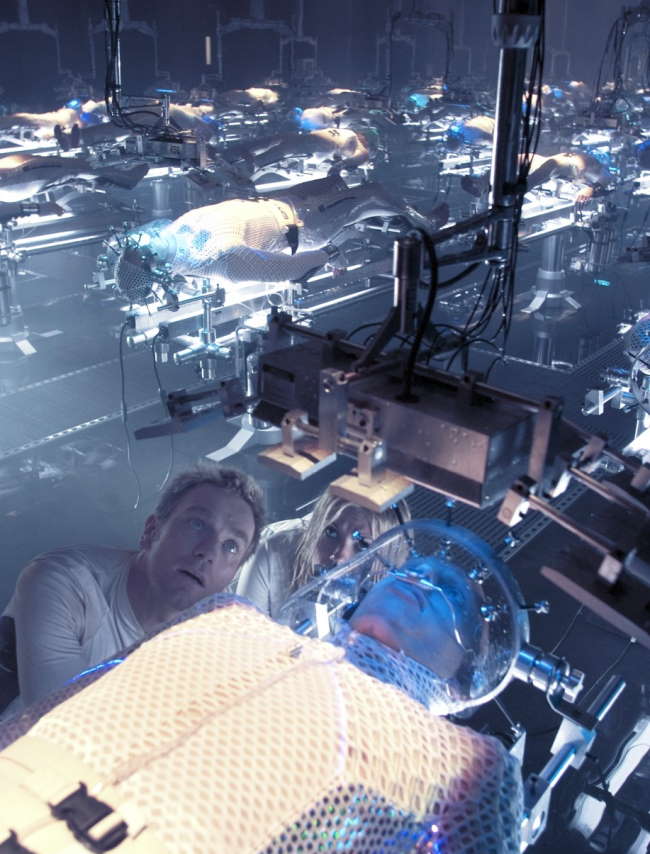
Overview: The Island is straight Hollywood fare from the get go. In this summer bubble gum scifi-action romp, you’ll find few original ideas here, or even a coherent plot, but you will find loads of awesome visuals and even more action scenes and explosions. Vast amounts of money went into creating some rather incredible action sequences. Unfortunately, with all the thought devoted to creating those sequences, there apparently was little left for the story itself. Still, Scarlett Johansson looks absolutely gorgeous in The Island, and Ewan McGregor works as a leading man.
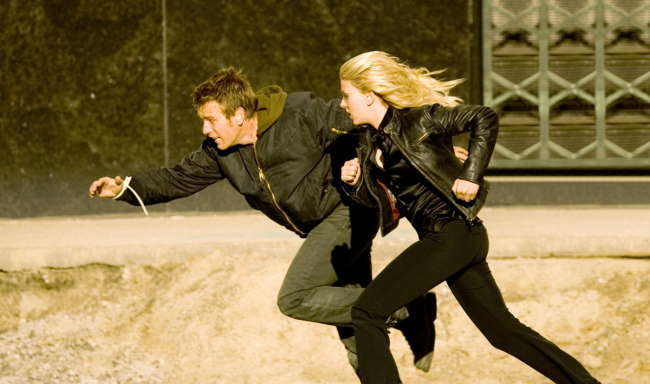
The Story: In the future, the desire among the rich and famous to live for ever dominates their existence. Along comes Dr. Merrick (Sean Bean) who founds the Merrick Corporation to meet this market need. The Merrick Corporation has (supposedly) found a method to take a person’s DNA and clone all of their organs within a gelatinous blob that maintains a persistent vegetative state. Unfortunately, they were never able to make this work, so instead, the Merrick Corporation broke all the laws and went with straight cloning of their human sponsors. For a cool 5 million bucks, sponsors can buy an insurance policy to ensure they always have a perfect set of organs that can be harvested to save them from whatever malady arises.
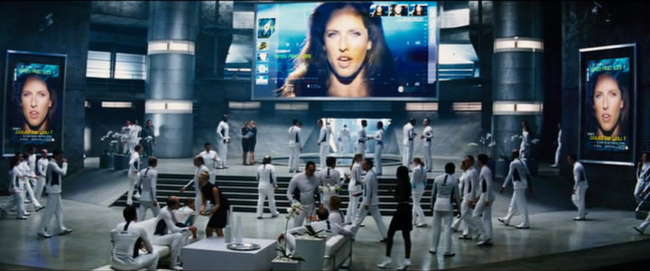
To keep the clones under control, Dr. Merrick constructs an alternate reality where a contaminated world has killed everyone except for a few fortunate souls who were rescued and placed into a special set of buildings. They have also saved an Island, which is now the only place on earth where people can live without dying. Now all the clones await their turn in the lottery, which, if won, supposedly means they will be able to go to the Island. In reality, the clones are “selected” when their sponsor has need for one of their body parts. From their diet to their associations with others to their urine output, every aspect of a clone’s life is monitored. THX-1138’s surveillance society, right down to the oppressive white, is omnipresent in The Island.
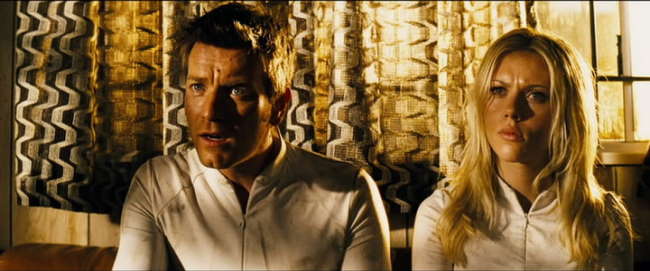
Lincoln Six-Echo, played by Ewan McGregor, is a clone who starts questioning his surroundings. He eventually gets out (through a completely idiotic plot point) and realizes that that those who leave to go to the Island are in fact being murdered. He quickly goes back to get his close friend, Jordan Two-Delta (Scarlett Johansson) who just yesterday was selected to go to the Island (her sponsor is dying from wounds suffered in a car crash). Together, they make a break for it, but are pursued by (we are told) a crack-group of ex-special forces agents led by Djimon Hounsou. With the help of a low-level employee (Steve Buscemi) that Lincoln Six-Echo befriended, Lincoln and Jordan make for Los Angeles in an attempt to find Lincoln’s sponsor to discover the truth. From there, The Island turns into a high-tech, futuristic chase movie, with continually larger explosions and action sequences dominating screen. I won’t spoil the ending for you, but suffice to say this movie is as predictable as they come.
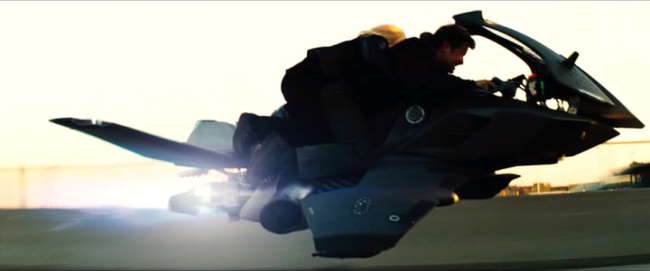
Michael Bay’s Approach to Story Telling: It’s pretty clear that director Michael Bay doesn’t plan movies like most directors. He seems to pay FAR more attention to the visual progression than he does the actual dialogue. The narrative in Island, like most of his movies, simply doesn’t hold together. To buy it, you have to accept all sorts of inane action on the part of the characters. Michael Bay seems to construct his movies via storyboards alone – for instance, he knows that in the end, the hero and the bad guy need to fight on a high-tech, scary looking bridge with explosions going on in the background – he is far less concerned about the rationale that brings them together. In watching it, the Island is one of those rare movies that is actually more coherent if you turn off the sound. The story you make up to go with the visuals will almost certainly make more sense then some of the plot points Bay provides.
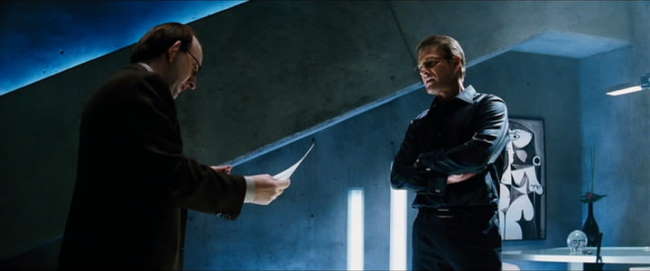
I don’t even mind that we have to accept that two clones, three and four years old, are able to outwit an entire platoon of ex-special forces personnel, or that they “magically” assume all of their cloned person’s skills (like riding flying motorcycles). I can even accept that a supervisor on a regular basis, gives a clone a key that gets him to the outside world to save the supervisor from running errands, or that the the police regularly park their squad cars in the middle of an intersection and then don’t look for broadsides, but some of the basic plot stuff really does bother me. In the Island, the cloning is a HUGE secret that implicates the entire corporation into illegal action, but none of the investors, including the Defense Department which as spent 120 Billion on this “technology,” ask any questions. Even more incredible, none of the hundreds, if not thousands of low-level employees have ever consider spilling the beans. Instead, they are so closed-mouthed, they don’t even tell their family members. Killing is cool for them, as long as they get to keep their meager paychecks. This is just one example – far worse are the ending plotlines, which have our heroes assuming that top-notch special forces personnel wouldn’t search them for weapons even after they’ve shot people (lucky for them, the special forces personnel complied), that hired thugs would hang out and watch their boss go mono-a-mono with the hero vice wasting our hero, and that the boss himself, up in the comfort of his office, would be able to make it to the hero far quicker than any of his hundred thugs who’s job it is to enforce the peace.

Product Placement Gone Wild: It’s kind of refreshing to know that in the future, all dehumanized clones have to wear Puma shoes and clothing, drink Aquafina, serve Ben & Jerry’s Ice cream to kids, model for Calvin Kline on billboards, play Xbox, seek out MSN Search as a phone book, conduct their slave work on Apple computers, steal American Express credit cards, snag rides on Mac Trucks, wear Monza watches, and look longingly at Michelob Light beers. And of course, EVERYONE will be driving either Cadillacs or Dodge Magnums in the future. The Bond movies, where you expect significant product placement, don’t hold a candle to the monstrosity that is The Island. Not only do we get an obscene number of product placements, the on-camera product “lingering” that Mr. Bay engages in is almost criminal. I felt like I should have gotten a discounted ticket due to the myriad of embedded commercials. It’s rather amazing if you think of it – that almost 70 years into the future, all these companies will still be using the same logos they use today. I must say though the product placements are very memorable – they make be both remember the product and more importantly, they instill in me the STRONG desire to never buy these products again, as I now associate these brands as contributors to fucking up my movie watching experience.
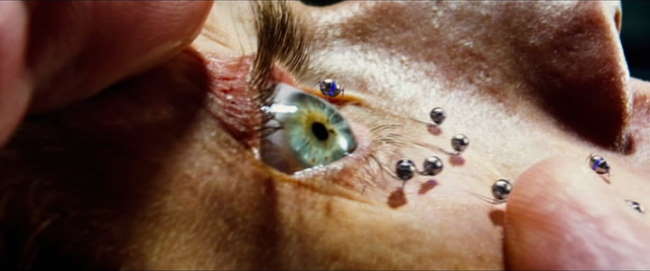
The Visuals: While I’ve bashed the Island’s plot, Michael Bay certainly deserves a lot of credit for delivering some pretty cool cyberpunk visuals. The clone development labs look pretty darn cool. Additionally, Michael Bay continually composes shots displaying wonderful color panoramas. We get gorgeous yellows and blues in a variety of textures and settings. In scene after scene, it becomes clear that while Bay isn’t too concerned about the dialogue or narrative sequences, he’s intimately involved in the look. In some cases though, the visuals, while impressive, make absolutely no sense – the worst example being the weird eye-nanobots that are needed to take pictures of the brain activity. That its necessary to have metal insects entering the eye in order to take a brainscan 70 years into the future strains credibility far past the point of reason – even worse, the brainscan cannot be processed until 48 hours!
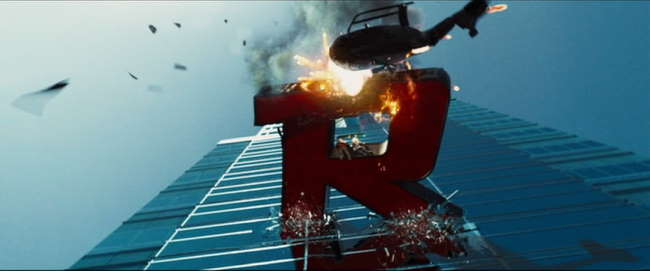
The Action Sequences: Michael Bay is known primarily for his outrageous and visually impressive action sequences. He does not disappoint in the Island as the action is consistently top notch. We get awesome explosions, incredible chase scenes and lots of gun fire and fight sequences, all with wonderful camera angles and high quality positional surround sound. If there’s one reason to definitely not miss the Island, it’s the action sequences. Michael Bay may not be a great film maker, but he and his crew are genius at constructing creative, eye-poppingly tense action.
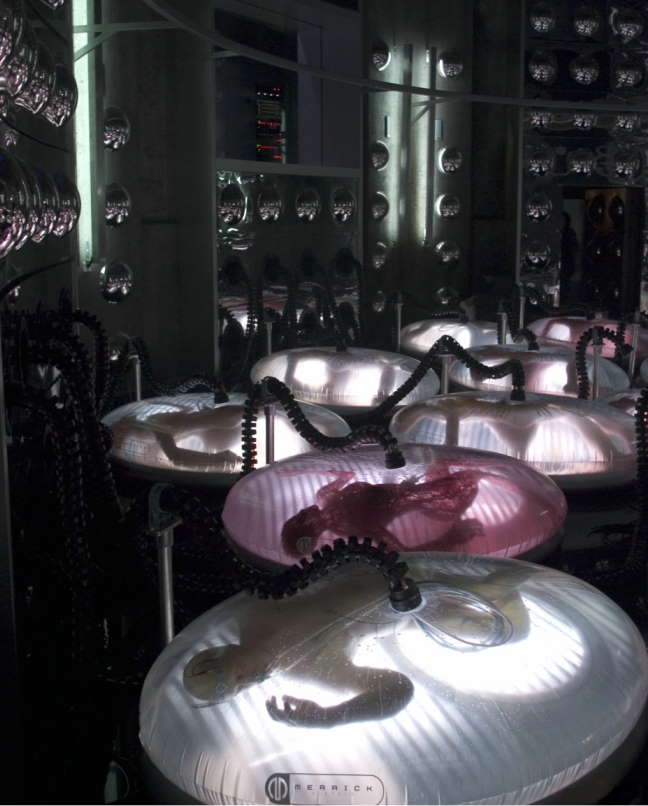
The Bottom Line: If there was one change I would make to the story, I would have suggested they had done away with the illegal nature of cloning (the second change would be to eliminate the magical memory transferral that happens between clones and sponsors). The Island would have worked far better if it portrayed a world were society as a whole had decided that cloned people were property. Instead, the Island practically ignores this question. But while I have a hard time suspending disbelief for the plot the Island provides us, I probably would have given it six stars, similar to a number of other Hollywood movies high quality visuals and significant plot issues. Unfortunately, the obscenely over-the-top product placement deserves at least the loss of one star. Not only are there over a dozen companies, the “linger” factor makes it clear that you’ve just paid to watch a commercial. In the end, this is simply asinine and reflects poorly on the studio (Dreamworks), the film maker (Michael Bay), and the products themselves (too numerous to mention). I would conservatively guess that the product placement easily cost the Island many tens of millions in lost revenue. The Island cost 126 million to make but only brought in 35 million, large part because virtually all reviews discussed the overbearing product placements. Word of mouth from viewers merely confirmed that if you pay to watch this in the theatre, you will be paying for commercials.
~See movies similar to this one~
Movie Review By: SFAM
Year: 2003
Directed by: Andy & Larry Wachowski
Written by: Andy & Larry Wachowski
IMDB Reference
Degree of Cyberpunk Visuals: Very High
Correlation to Cyberpunk Themes: High
Key Cast Members:
Neo: Keanu Reeves
Morpheus: Laurence Fishburne
Trinity: Carrie-Anne Moss
Agent Smith: Hugo Weaving
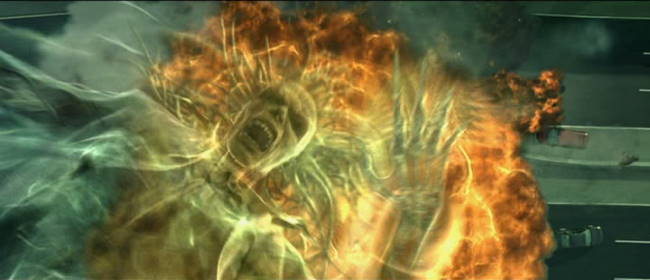
Overview: Matrix Reloaded, one of the most anticipated movies of 2003 provides a very interesting follow-up to one of the best, most influential movies in cyberpunk and all of Sci-Fi. Many have knocked this (and Revolutions more) for being a significant step down from the original movie, and to an extent they are in that the “newness” of the idea has worn off. But truly, it would be absurd to expect the Wachowskis to not use the universe they have already painstakingly created. In this sense, the sequels HAVE to provide a different sensation. In this sense, Reloaded does not disappoint. We get great performances by the Matrix leads, along with a number of truly terrific supporting roles. For this review, I’ll try to concentrate my comments more on the Sci-Fi aspects of the movies versus the religious narrative, as this also covered wonderfully elsewhere. I’ve also tried to use less well known screencaps on the first page of this review. To see some of the more popular Reloaded screencaps, go to page 2 of this review. Also, this review goes in line with my more in-depth assessment of the trilogy from a SciFi perspective:
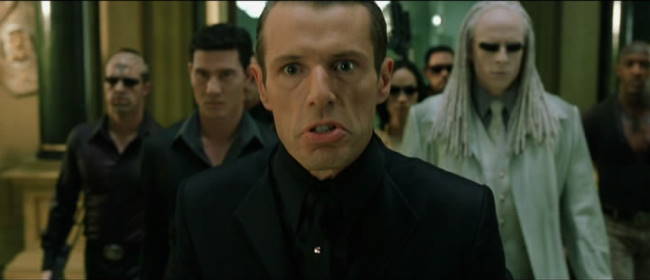
No “The Matrix Sucks/No It’s Great - You Just Don’t Understand!” Debates: Just a fair warning – if youre expecting Matrix sequel bashing, I’m afraid you’ve come to the wrong site. There are numerous places to read such banter if you’re interested. I absolutely love the sequels for a variety of reasons (some of which I explain below), but I really don’t mind in the least if you hate the sequels. Yet, for this movie, I’d really like the comments on this entry to be more related to the movie itself versus whether or not you hate the sequels. Believe me when I tell you I’ve participated in many more hours of discussion on this topic than I ever care to, and absolutely will not get into this in the comments section of this review. If you MUST engage in the “Matrix Sequels Suck/No - They’re Great, You Just Don’t Understand!” debate, please use this thread in the Meatspace.
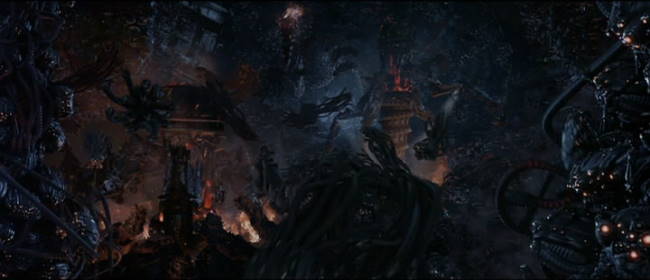
The Story: I’m going to go out on a limb here and guess that about 99.9% of you reading this review have already seen Reloaded, so I won’t spend much time on an overview of the story unless its specifically requested. In brief, Matrix Reloaded is the sequel to the Matrix, and is the second of three movies in the trilogy. In Reloaded, six months have past since the end of the Matrix, during which time, Morpheus, Neo and Trinity have been busting hump freeing massive numbers of battery people. In Reloaded, we get to see Zion, a return of Mr. Smith, and eventually, a fuller understanding of the nature of the Matrix and the Prophecy of the One.
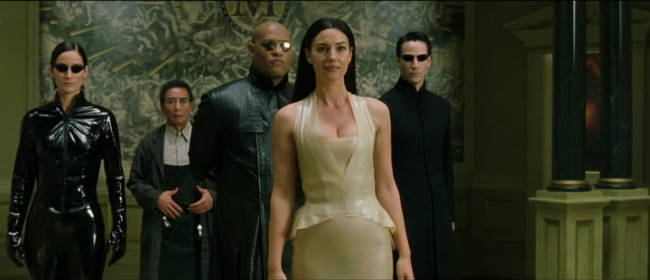
The Supporting Characters: One of the real strong points of Reloaded is the cool character additions. The best ones are of course the Merovingian (played magnificently by Lambert Wilson) and Persephone, played by the ultra-sexy Monica Bellucci in a totally hot see-through dress. When they are onscreen, both absolutely steal the scenes. Almost as terrific is the Architect (Helmut Bakaitis) and the blasé evil ghost twins (Adrian and Neil Rayment – who actually are twins) – they have to be up there as some of the best henchmen ever to grace the screen. Seraph (Collin Chou), Councilor Hamann (Anthony Zerbe), Link (Harold Perrineau), the Keymaker (Randall Duk Kim), and Niobe (Jada Pinkett Smith) all really add to the movie as well.
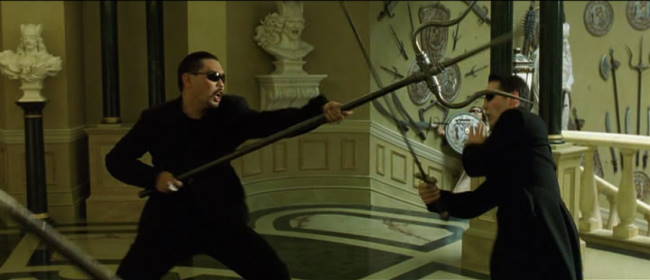
The Action: Reloaded is filled to the brim with awesome action scenes. In addition to some wonderful Woo-ping Yuen choreographed fights, we get one of the best highway chase scenes ever put on film. The Trinity motorcycle part in particular is just awesome. Truly though, serious credit has to go here to Keanu Reeves’ preparation and training for this film. By all accounts he was an absolute machine in terms of preparation. It really shows on screen. His wire work and martial arts scenes are just terrific (And no, I’m not comparing him to those in Hong Kong who’ve spent an entire career doing this stuff). The CG for the most part is absolutely top notch.
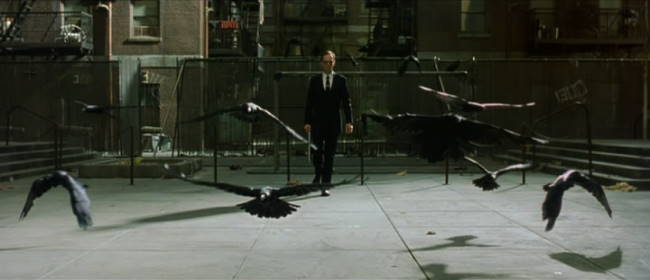
The Visuals: Matrix Reloaded has a lot more diversity in its visuals than the Matrix provided us. We have a few experimental shots like the graphic novel scene of Neo flying with the Moon behind him – and lots of yellows and greens. For yellows, we get rave scenes, explosions, and fights in a yellow weapons room. Greens, of course, still dominate the majority of the scenes – like the first movie, they are omnipresent in most low-light scenes. All in all, the visuals are incredibly diverse and interesting.
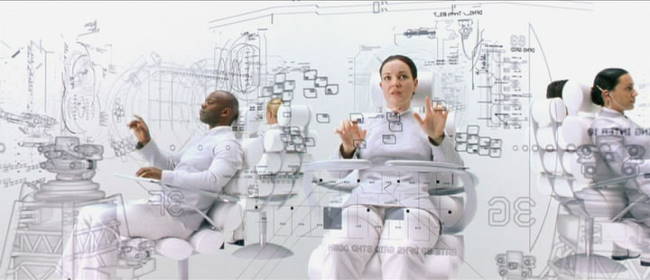
The Pacing: Matrix Reloaded starts off with a bang (literally) before getting into the story. We get a mixture of plot discussions, action sequences and philosophical breaks. But Reloaded is as a whole is definitely of a different style pacing than most movies. It and its sequel more closely resemble the approach taken in Oshii’s Ghost in the Shell, where there are philosophical and thematic discussions that are then played out in the action sequences. The ending clearly comes off as a cliff-hanger, which is to be expected considering this is the middle of a trilogy.
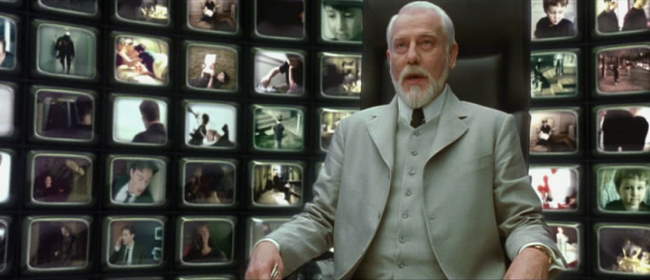
The Architect Conversation: The Architect conversation provides some of the best dialogue of the entire trilogy. This is a philosophical break, a plot buster, and more importantly, the major turning point in the trilogy. The Architect and his minions serve as the ultimate representation of a negative feedback (negating change from an initial goal state) control system. His whole purpose in life is to ensure a steady supply of power (electricity) to the Machine City. As the power is created off the electricity in humans, the Architect must develop a plato cave-like virtual reality simulation that provides humans with a believable reality. The Architect reveals the details of the control system that has kept the machines satiated with electricity for the past 600+ years. In this we find that the prophecy of the One is merely one more layer of control to maintain the status quo to handle the problems arising from freewill (more on this below). Unfortunately, something (or someone) has thrown a monkey wrench into his carefully laid plans. Neo has fallen in love, and in so doing, creates a personal connection with a human that is potentially larger than his overall connection with humanity.
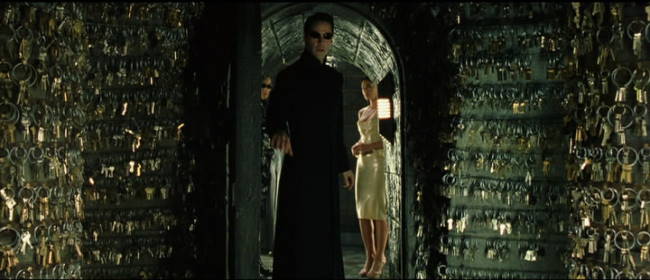
Freewill: Matrix Reloaded spends a good bit of the philosophical breaks discussing the impact of freewill on actions, decision making and on control systems. The Merovingian assets that without the “why,” freewill is merely a facade by those in power that is placed on the powerless. The architect who created the Matrix based on mathematical equations. While he has accounted for almost all anomalies, he had to develop a special periodic subroutine to address the issue of freewill. Because a very small subset of the population would reject the Matrix programming, there needed to be a way of handling this. His approach involves the creation of an external holding bin called “Zion,” which which he would let fill up with the problem battery people, and then every hundred years or so would clean out the holding bin and start again. Simultaneasly, Morpheus, who is unaware of this freewill control subroutine, sees the prophecy of the One as a deterministic journey - one which both reduces the power of freewill while supposedly saving Zion.
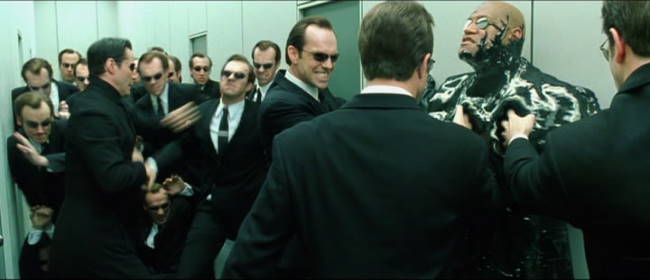
Positive Feedback Out of Control: From a cybernetic standpoint, Positive feedback, or the deviation from an initial goal state, plays a huge role in both reloaded and revolutions. In fact, both movies constitute an emergence and interplay among dueling feedback systems. The architect has created a negative feedback system that has been in force for at least 600 years. Yet now, the perturbations to the negative feedback control system are systemic – in fact, they constitute an initial kick in an entirely new direction. The study of cybernetics tells us that negative feedback systems are destroyed – often never to be repaired to their original state – if the upper or lower threshold values in the are exceeded. For instance, if the body temperature in a human exceeds 106 degrees Fahrenheit, the human will die. In the futuristic dystopia of the Matrix, this is the strategy the Oracle takes. The rationale is that unless the architect’s control system is rendered moot, the “ebony and ivory, living in perfect harmony” future (with machines and humans) the Oracle desires cannot occur.
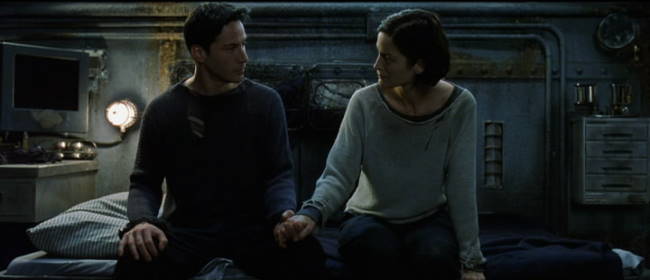
Elements of the positive feedback system, represented in totally by the Oracle and the causality she creates, include both a modification of Neo’s operant conditions and an intrusion into Mr. Smith’s deletion. Neo’s love for Trinity changes the outcome of the Architect’s freewill subroutine – instead of having only one real choice (saving humanity), Neo has a new choice – save trinity now and spend 24 hours trying to rescue Zion and humanity or continue with the control system which will wipe out Zion. Additionally, Mr. Smith has been transformed into a virus. When Neo destroys him in the first movie, Mr. Smith did not disappear – instead (as we find out in Revolutions), the Oracle intervenes and creates the new, viral Smith. While there is no resolution to this in reloaded, the context is set for the resolution in Revolutions.
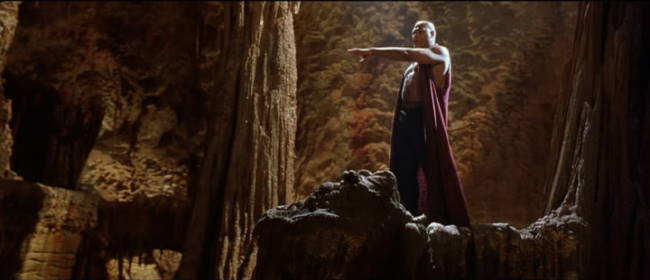
I Believe…: I believe this phrase (“I believe”) is used twenty times or more in Reloaded. There are times it fits perfectly, whereas others it seems to interfere with the dialogue. The scene where Commander Lock is discussing strategy with the Council is the most egregious example of this. Versus “I believe we need every ship…” it would have been far more realistic had he used a simple “We need every ship if we are even to have a chance…” The problem of course is the whole issue of whether or not the Commander and Council believe in the Prophecy of the One. As impending doom draws nearer, the tendency to place faith in supernatural explanations for salvation becomes too great to resist.
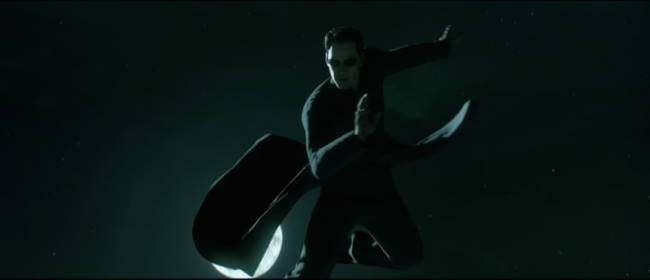
The Bottom Line: The Matrix Reloaded is a terrific follow-up to one of the most influential movies ever. The Wachowski brothers have provided a movie where the action is terrific, the characters are memorable, and the narrative is complex and interesting. Lawrence Fishbourne as Morpheus in particular shines here, which is great, in that is role is significantly diminished in Revolutions. While Reloaded suffers somewhat from being the middle movie in a trilogy, I think it handles this well. The ending provides us with a cliffhanger, which, at the time of release, sparked IMENSE numbers of interesting theories and ideas. I’m guessing most of you have watched Reloaded, so I feel strange giving a plug to watch it. All I can say is I love it.
Page 2: More Screencaps –>
~See movies similar to this one~
Movie Review By: SFAM
Year: 2002
Directed by: Kazuto Nakazawa & Naoyuki Yoshinaga
Written by: Chiaki Konaka
IMDB Reference
Degree of Cyberpunk Visuals: High
Correlation to Cyberpunk Themes: Medium
Key Cast Members:
Basil: Kazuhiko Inoue
Reiko Michaelson: Akemi Okamura
Rod Kimball: Somei Uchida
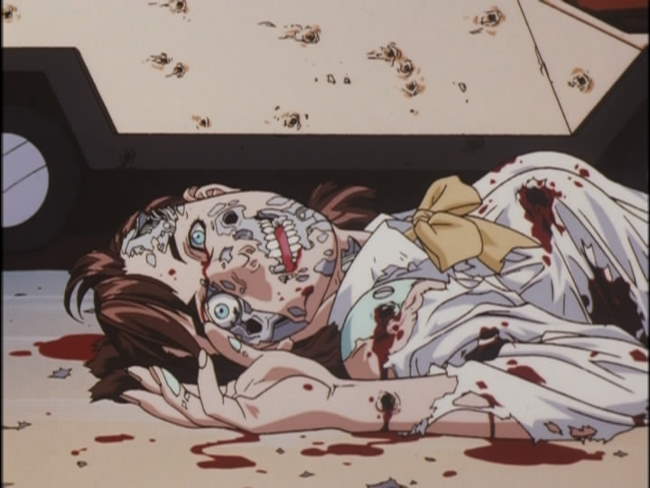
Overview: Parasite Dolls, another cyberpunk anime written by the prolific cyberpunk anime master, Chiaki Konaka (Serial Experiments Lain, Texhnolyze, Armitage III, Malice@Doll, and Bubblegum Crisis 2040), is a visually interesting, VERY adult OVA from the Bubblegum Crisis universe. The androids (called boomers) in this show are fully android (at least regarding their mental processes) unlike in other Bubblegum stories where they seem to be a combination of human and android. While this is a three part OVA, I really like that they are almost integrated like a movie, versus as separate episodes. Fair warning, you get gruesome deaths in the throws of sex, prostitution, lots and lots of gore.
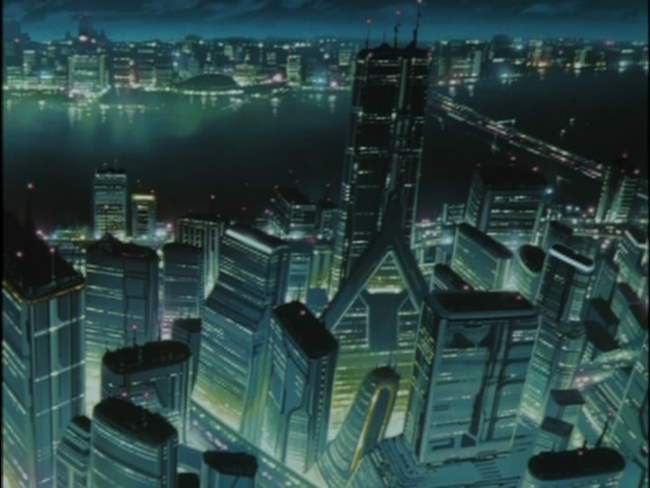
The Stories: There are three separate, interlinked stories on the Parasite Dolls OVA. At the start of the first story, set in the year 2034, where society has become a troubled mix of humans and androids called “Boomers.” The Genom Cooperation has created boomers to serve mankind in all aspects, from police support to sex dolls. Unfortunately, problems emerge, both with the boomers and with humanity’s reaction to their presence. A clandestine division of the Advanced Police (A.D Police) called “Branch” has been created to investigate human to boomer related crimes. The story follows “Buzz” Nikvest, a policeman with a troubled past, and his partners at the Branch division, which include a very helpful Boomer called Kimball and a stereotyped spunky, sexy, tough cop chick named Reiko Michaelson.
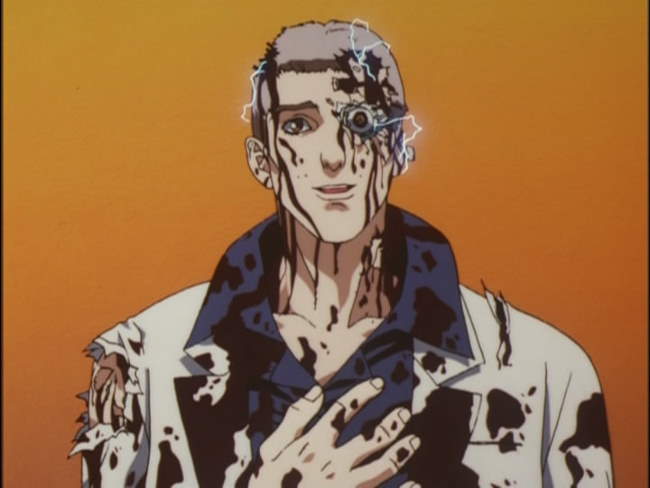
In the first episode, rogue boomers start randomly attacking and killing innocent humans. Buzz and company are brought in to investigate. During the course of their investigation, they find that things at the Genom corporation are not all above board. This story has some pretty cool visuals of shot-up boomers, and a few interesting
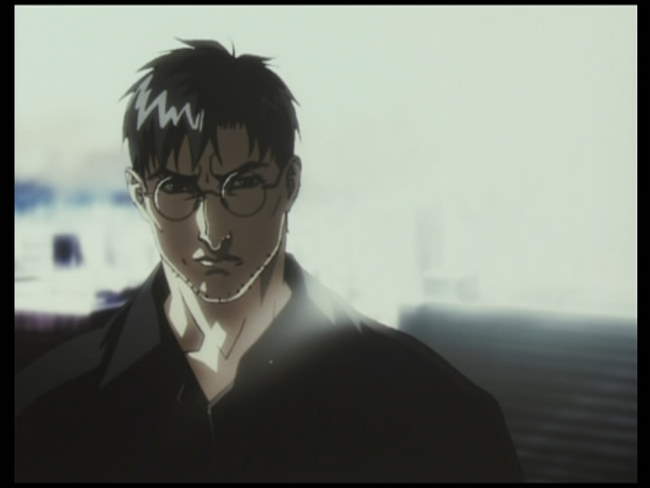
The second episode, which takes place a year later, involves a truly bizarre android monster called the “Boomer Crusher” and a very lifelike boomer prostitute who has feelings and has dreams. Unfortunately, the prostitute is being controlled in her dreams to cause some truly bizarre human deaths. We find out more in the third story of who probably created this monster, but it isn’t really stated in the narrative.
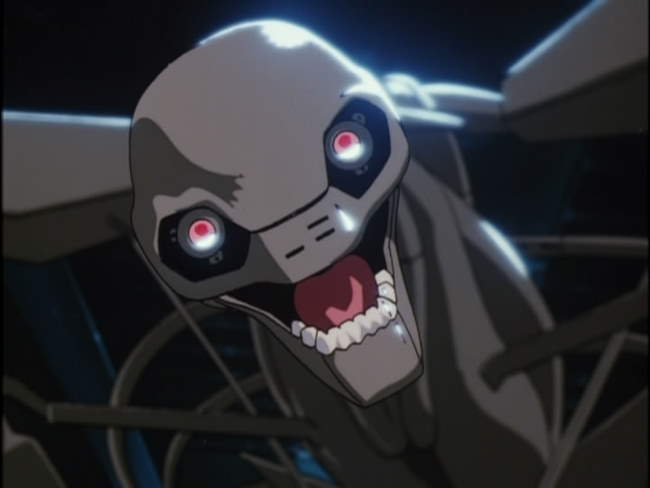
In the third episode, which takes place 5 years later, Takahashi, the head of Branch Division is missing. In searching for their missing box, Buzz, Kimball and Reiko find a connection between Takahashi’s disappearance and the recent spate of anti-boomer activity that has grown in recent years. Worse, as explosions go off all over the city, Buzz is framed as the fall guy. As the story unfolds, the viewer is left with the idea that all three stories are related to the same larger plot.
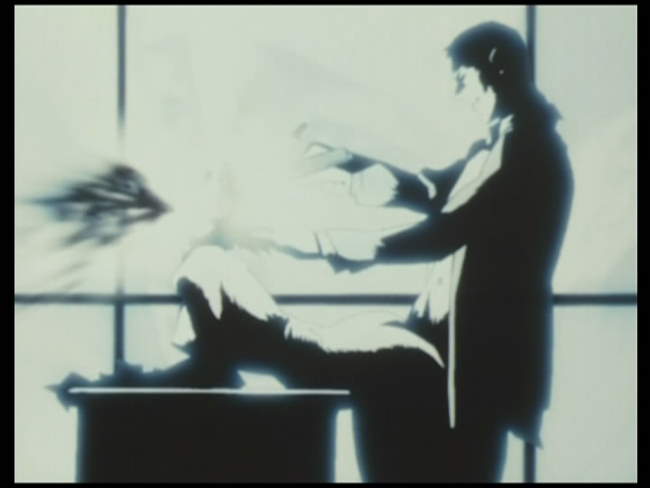
The Visuals: Parasite Dolls has a really nice diversity of looks, often emphasizing extreme shadows in single color light settings. Both blue and gray are used extensively for this, often yielding terrific visuals. In other cases, Parasite Dolls looks like a rather decent, but not spectacular anime. It does best when it strives for the edgy look. Had this been used throughout, Parasite Dolls could have come off as something bordering on special. As it stands, some parts really stand out, while others you almost wait to get through.
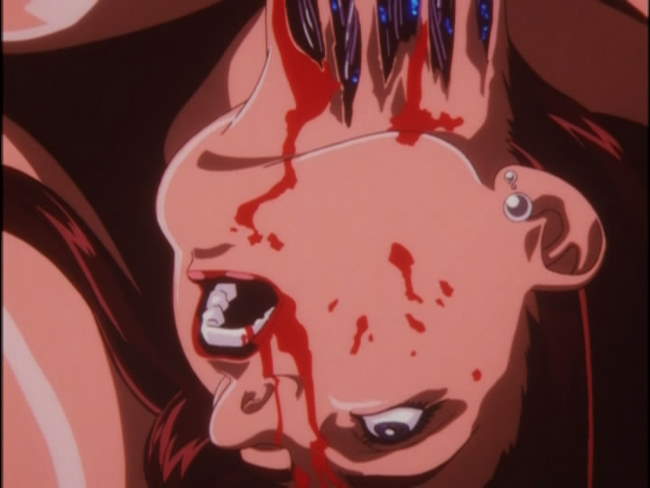
Boomers – property or unique individuals: Nothing new here – Parasite Dolls explores the continually explored question of whether androids are merely property or something more unique. Unfortunately, no new ground is traversed. Instead, the interesting aspects of this come from the seedy visuals themselves. There are a few scenes in Parasite Dolls where the visuals make a far more interesting statement than the narrative. These usually involve truly gruesome Boomer deaths.
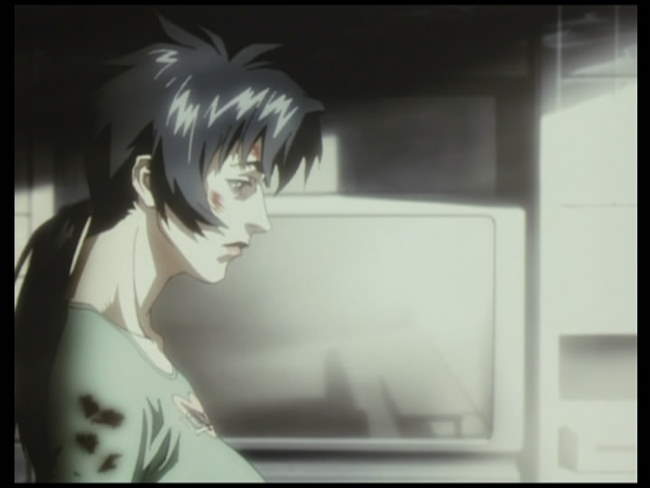
The Seedy Underground: A seedy feeling pervades Parasite Dolls. We get nudie bars, slovenly side-walks, seedy corporate meetings, and absolutely base human behavior. We have hot chick boomers continually debased and abused. Even the weird creatures that appear have an icky feel to them. The constant theme we see here are fallen boomers. They had so much potential, but…
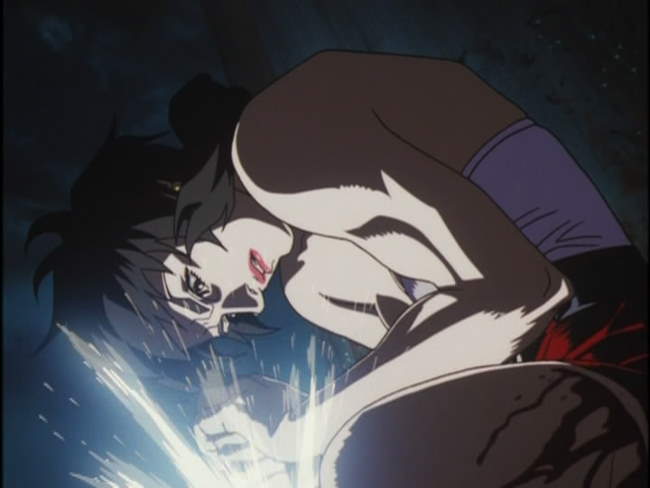
The Bottom Line: The stories themselves are somewhat uneven and problematic, but the visuals are interesting enough to make this worth a watch. While the narrative is more straight forward than many of Chiaki Konaka’s stories, it does require a few minutes thought to put the overall picture together – otherwise, all three episodes almost seem disconnection. Even though Buzz is a pretty interesting character, the rest of the characters we encounter are pretty much the cookie-cutter variety. Worse, as the episodes take place over a six-year time period, you would really expect to see growth in the characters, or at least changes in the nature of their relationships. Instead, the characters we encounter at the beginning are the same ones six years later. Still, for a 3 part OVA, Parasite Dolls is worth a watch for the visuals alone.
~See movies similar to this one~
Movie Review By: SFAM
Year: 2005
Directed by: Karyn Kusama
Written by: Phil Hay & Matt Manfredi
IMDB Reference
Degree of Cyberpunk Visuals: High
Correlation to Cyberpunk Themes: Medium
Key Cast Members:
Aeon Flux: Charlize Theron
Trevor Goodchild: Marton Csokas
Oren Goodchild: Jonny Lee Miller
Sithandra: Sophie Okonedo
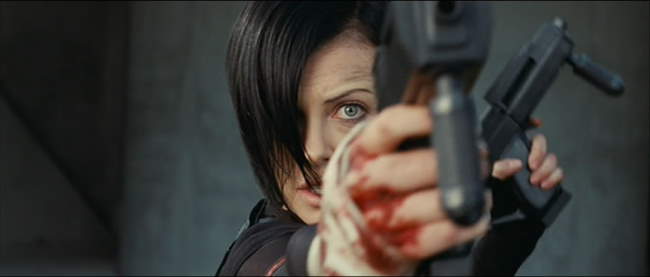
Overview: In the best of cases, remakes of cherished shows rarely turn out good. The MTV Aeon Flux cartoon series was an intensely creative post-modern show by Peter Chung, who broke all the rules of how narratives are supposed to be told. The lead character, Aeon Flux, the ultimate anti-heroine, dies on a regular basis; nobody was purely evil or purely good; and everything was high-tech body modification chaos. Unfortunately, the movie does away with all that. In an attempt to “humanize” the iconic figure of Aeon Flux, the movie version goes for a standard rebels-versus-Orwellian bad guys movie with a twist. While some of the visuals are absolutely terrific (including some wonderful action scenes by Charlize Theron), in the end, this is a very different story with very different characters, and must be understood as such.
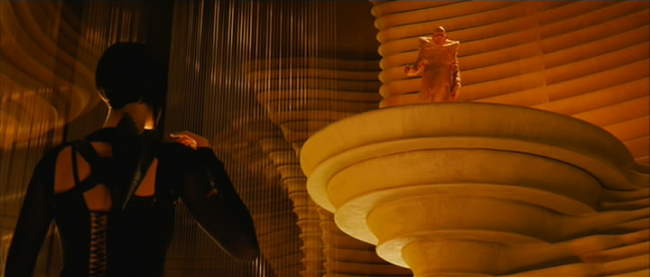
The Story: Aeon Flux takes place 400 years after a virus has devastated humanity, killing off 99% of the population. Now, one walled city named Bregna, holding 5 million people is all that remains of humanity. Bregna is ruled by a council of genetic scientists who have (supposedly) been avidly working on fixing the fallout of the virus for the past 400 years. For reasons only partially explained later in the story, the ruling council has instituted a totalitarian government with an extreme crackdown on personal freedoms, and have backed their authority with an intense surveillance apparatus. A group of rebels called the “Monicans” have challenged their right to rule, and have vowed to destroy the ruling council, especially their leader, Trevor Goodchild (Marton Csokas), at all costs.
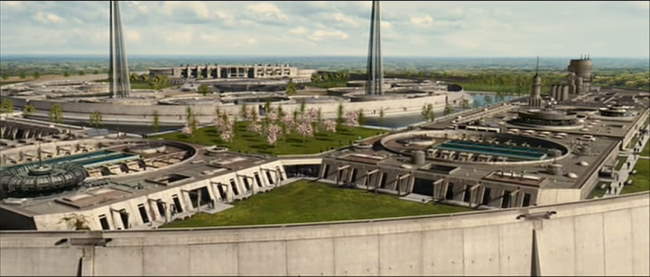
Aeon Flux (Charlize Theron) is the Monican’s very athletic, butt-kicking, black spandex wearing operator-extraordinaire. No mission is too dangerous, and no obstacle is insurmountable. In what serves as the prologue, Aeon’s last surviving family member, her sister is killed by the Bregan Council authorities – all that remains for Aeon is revenge and the mission. Finally her time comes when the fiery-haired Monican handler (Frances McDormand) authorizes her to go assassinate Trevor Goodchild. So Aeon and her partner with four hands and no feet, Sithandra (Sophie Okonedo), storm the garden and infiltrate the Brega Council compound.
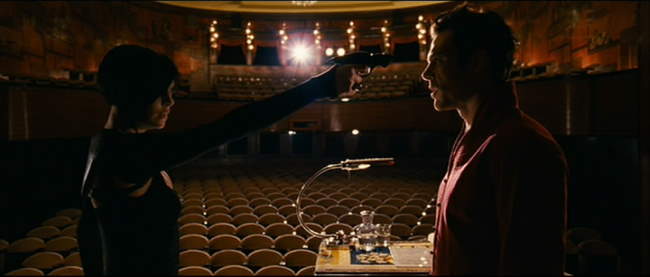
Unfortunately, as Aeon finally encounters Trevor, not all is at it seems. She suddenly has memories of kissing Trevor in a former life. Worse, it looks like there are other forces at work, and perhaps Trevor isn’t the bad guy the Monicans have made him out to be. As Aeon follows her heart and the ever expanding mystery, she engenders anger from the Monicans, while Trevor ends up at the wrong side of a coup-des-tat at the hands of his evil brother, Oren Goodchild (Jonny Lee Miller).
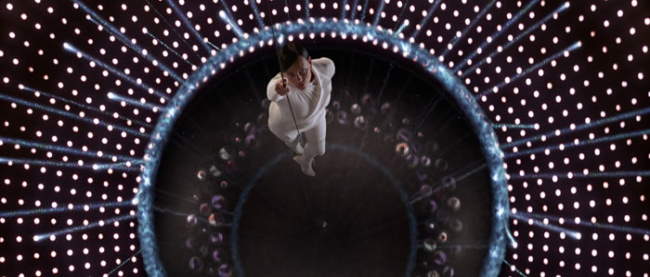
Story Problems: While the front half of the Aeon Flux story works, the back-end is riddled with inconsistencies. If you spend an ounce of time thinking through the motivations, the actions of the main bad guy make no sense. What he really wants (immortality) can be accomplished even Trevor’s experiments prove successful. This is muddied further when the Jurassic Park mantra, “Nature finds a way” is added to the mix. Even weirder is Pete Postlethwaite’s character, who comes across almost as the watcher in a Fantastic Four comic. We are never sure if he is real or Memorex. Worse, his final monologue where he explains his actions adds yet another strange element to the scifi-mix – precognition. In the end, there are too many fantasy-like technologies for this to come across as believable. In brief discussions with on the writers (Phil Hay), it appears that the original script might have been tampered with. I really hope this is the case, as the visuals of the movie were more than strong that they would work for even a passable story.
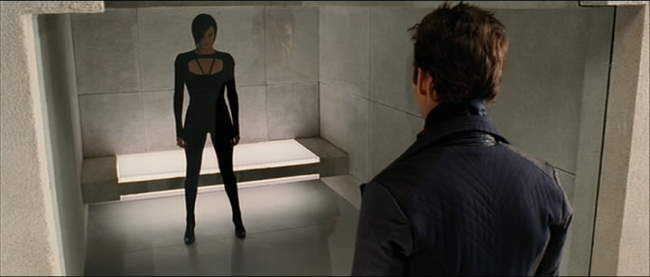
Changes With Aeon and Trevor From the Cartoon: The move version of Aeon Flux in no way matches the lead characters of Aeon Flux and Trevor. In Peter Chung’s cartoon, Aeon Flux comes across as the ultimate anti-heroine. While she clearly knows right from wrong, and generally tries to stop the worst abuses, Aeon is an ultra-acrobatic, top-notch action-espionage heroine who works for herself, and only operates under her own agenda. Trevor is a mostly malevolent, superior dictatorial character who as a true soft-spot for Aeon. For her, he will bend his approach, but otherwise he rarely is a nice guy. We rarely see fear, doubt, or self-loathing out of Aeon, although she too has an eternal love for Trevor that trumps all. Kusama’s version of Aeon and Trevor tries to humanize them, and in doing so, removes much of their uniqueness and appeal. New motivations and afflictions are created where none previously existed. Worse, their very nature changes. In the end, Trevor turns out to be a misunderstood hero who works valiantly to save humanity – his only fault is he turns a blind eye to his brother’s excesses. Aeon becomes an agent working for others goals, but only later turns to herself based on principled evaluation of what is right and wrong. Again, while both of these characters may be interesting if done well, they bare little resemblance to the mindset of the Aeon and Trevor characters from the original show.
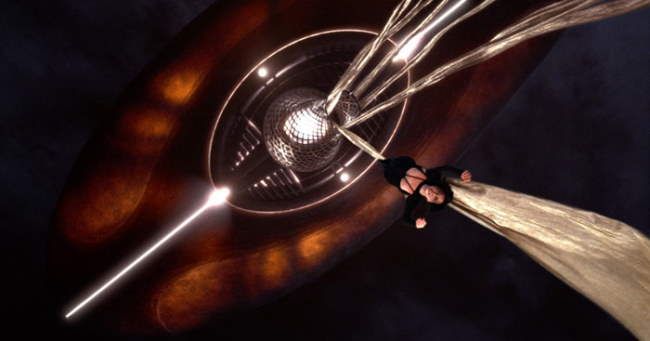
Still, I must give credit to Charlize Theron’s athletic feats in this movie. By all accounts she spent 3 months training to be a gymnast and fighter, and it shows. While for the most part she does away with the ultra skimpy clothes from the cartoon, she really does nail the gracefulness and style of the cartoon Aeon Flux. And while I don’t necessarily agree with the humanization approach, Aeon does pull this off very well, especially considering she has very little dialogue. The fact that she got seriously injured on the tenth day of shooting (herniated disc injury), but came back to continue the vast majority of the stunt work is a testament to her commitment and professionalness, and should be applauded. If I had one complaint with her protrayal, she really doesn’t really “look” the part, in that the cartoon character was a taller figure with a far more angular face and tapered hair.
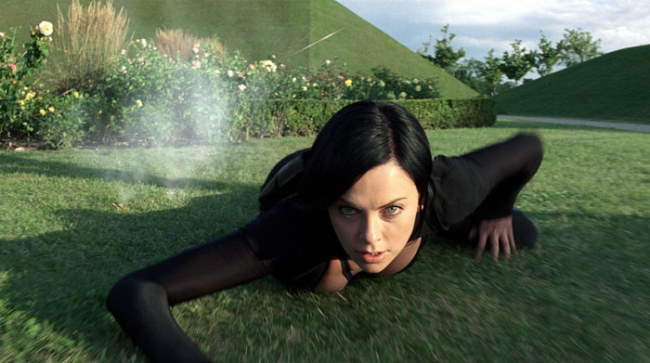
Editing is Way Too Frantic: Aeon Flux was a very contemplative animated show. Almost always, you had time to properly digest a scene. The atmosphere of the original series is largely based on the pacing. In the movie version, the editing seems designed to artificially hype the tension. In the end, it results in sucking the life out of many of the scenes. You rarely have time to feel connected to the scenes. More often, you feel like you’re riding a roller coaster, even when the scene is nothing more than two people talking.

The Technologies in Aeon Flux: The body modifications (such as hands replacing feet, and various stuff stored within the skin) in Aeon Flux really added to the visual appeal. Also, there were a number of interesting technological innovations. Probably the biggest was the peer-to-peer interaction in “brain space” that the Monicans use to elude the Orwellian-style surveillance systems that the council has set up. The flat metal slices that turn into semi-autonomous exploding balls were visually cool, as was the room that worked in two dimensions (each dimension of frequency holding completely different items). I also liked the bubbling Band-Aids that Aeon has stored, hiding on her skin.
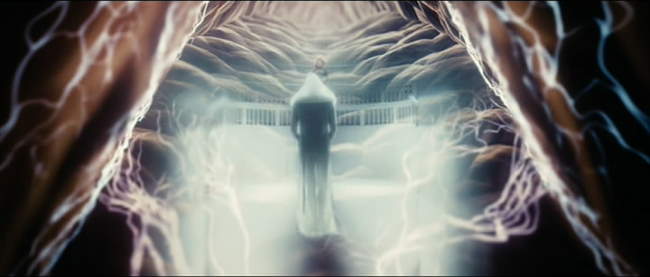
The larger technology involved cloning. In Aeon Flux, cloning equates to flawed reincarnation. With each generation the people are cloned, the memories of their lives somehow stay with their soul – yet with each time they are cloned, the new person has memories from the previous versions. Over time, the cloning ends up destroying each other’s reality. For the most part, I don’t think this idea worked all that well. It gets especially troublesome when we look at the Keeper, who seems to be able to “remember forward” and thus, make decisions 400 years ago that will help save the world well into the future.
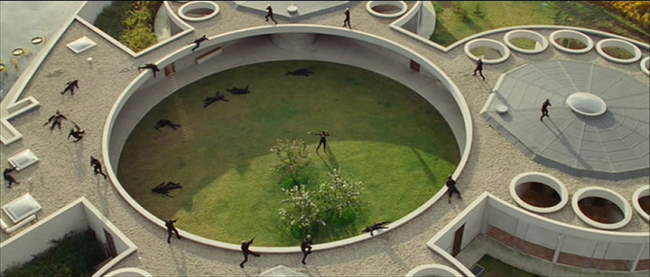
The Visuals: Visually, Aeon Flux is a gorgeous movie. We have also sorts of beautiful futuristic city settings, beautiful characters, and really fun FX. Some of the visuals are completely nonsensical though – the most egregious being an early scene involving Aeon wearing white for the ONLY time in the movie when she wants to stealthily sneak into the Brega compound at night. While this helped make Aeon’s character stand out more, it immediately brings a sense of Hollywood unreality to the whole affair. Still, while many of the action scenes didn’t make lots of sense, they were all nicely shot. Some of the fights were pretty gritty, but for the most part, the resembled a gun-version of a kung-fu dance movie.
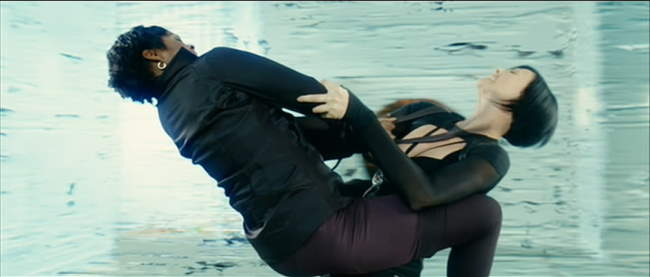
Lots of Hawt Chick Fighting! One of the better aspects of Aeon Flux involves the massive amounts of hawt chick fighting! Yes, its low-brow, but we like it. We get some really juicy fights between Aeon and Sithandra, and Aeon and Trevor’s bodyguard, Freya (Caroline Chikezie). And of course we have massive amounts of Charlize Theron in tight black spandex, kicking butt. While some have compared this aspect to Catwoman, the comparisons are unfair in that 1) we don’t have Mouseketeer ears, 2) all the fighters are very athletic, unlike Sharon Stone in Catwoman, and 3) the fight choreography is far far better.
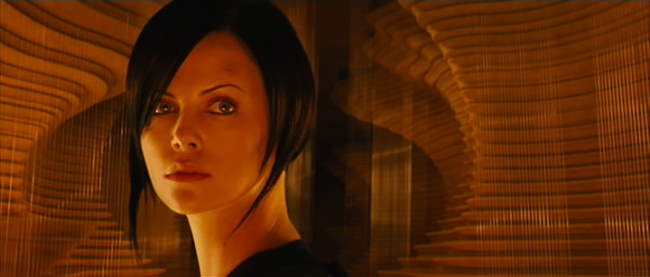
The Bottom Line: While there enough to like in Aeon Flux to give it a passing grade, I really can’t give it more than that. A movie version of Aeon Flux should have been a creative, postmodern event that stayed true to the cores of the characters in the cartoon. Evidentally, the studio thought an innovative approach such as this wouldn’t fly with the vast movie-going public. What was created instead, even though different, could have been decent, but was mired down with horrid editing choices and incoherent motivations in the later half of the story. In the end, it’s hard to buy a number of the decisions various characters made.
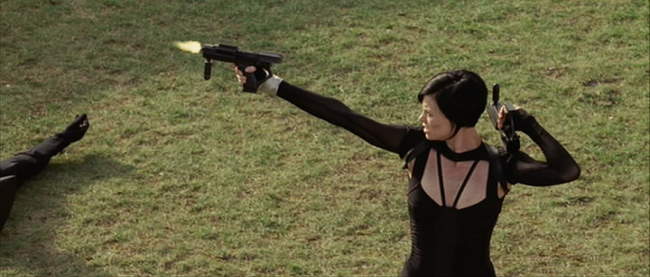
However, the narrative problems in Aeon Flux may be due more to ridiculous studio meddling than with the actual script – apparently the editing was one casualty of studio meddling. Phil Hay has indicated that he will write an essay on how the Director’s Cut would have been different. He is hoping that DVD sales will be high enough that the studio will agree to release the Director’s Cut, which he claims is a very different movie. Still, Charlize Theron’s excellent acrobatics makes for good eye candy, and turns in a credible performance as a humanized version of Aeon (the Trevor portrayal is completely uncrecognizable from the cartoon though). The visuals are terrific, and the technology is pretty interesting. Similar to other 6 star movies that are high on visuals but have problematic stories (Ultraviolet, T3, Appleseed), you may still be interested in giving this a watch.
~See movies similar to this one~
Movie Review By: SFAM
Year: 2001
Directed by: Sogo Ishii
Written by: Sogo Ishii
IMDB Reference
Degree of Cyberpunk Visuals: High
Correlation to Cyberpunk Themes: Medium
Key Cast Members:
Dragon Eye Morrison: Tadanobu Asano
Thunderbolt Buddha: Masatoshi Nagase
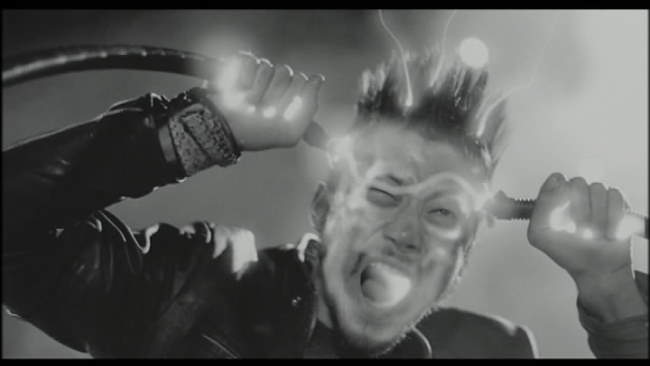
Overview: Sogo Ishii, master of the Japanese Extreme Cinema delivers a truly bizarre experience for us in Electric Dragon 80,000V. If you added the dialogue from this whole movie up, you probably wouldn’t get much more than a page or two. The story is told through visuals, and that said, the narrative itself isn’t all that deep. So why do I give the movie a decent rating? Simple – the visuals and the overall mood this film creates are absolutely unique. Electric Dragon 80,000V is first and foremost an experiential flick. The narrative definitely takes a back seat to the visual and sound integration.
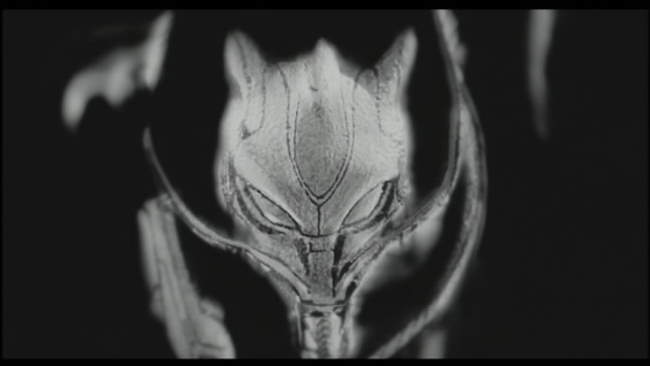
The Story: Electric Dragon 80,0000V follows the maturation of two kids who had traumatic experiences with electricity when they were young. One, Dragon Eye Morrison (played by Tadanobu Asano, who also stars as Kakihara in Ichii, the Killer), underwent electric shock treatment due to being violent as a kid – specifically, he endured 80,000 Volts of electricity. When Dragon Eye Morrison undergoes electric shock treatment, something in his reaction awakens the Dragon. The Dragon is the Eastern style dragon – one that’s embedded in all living things and the world at large. Dragon Eye Morrison’s connection with the dragon releases the rage within in, and thus, forces him to get more shock treatments. With each electric shock treatment, he develops a deeper connection with the dragon. By the time he’s an adult, Morrison can commune with reptiles (he owns a bunch), and has learned that playing REALLY LOUD guitar music (well, playing really loud anyways) is able to sooth the rage within him.
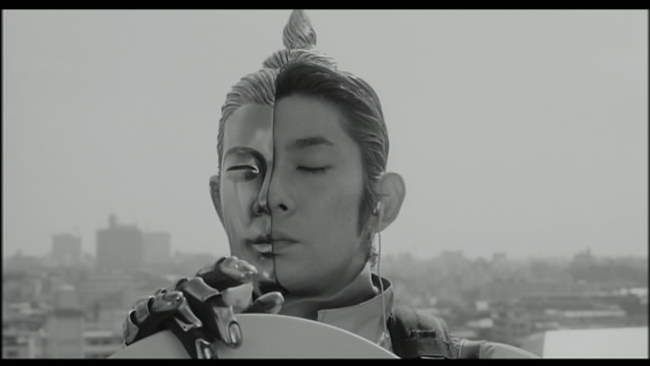
The other, Thunderbolt Buddha (Masatoshi Nagase) got electrocuted with 20 million volts while attempting to climb a power-line tower. The electricity is so high that half of his body becomes encased in metal – and in fact his personality is as split as his body. One side of him is trying to kill himself, while the other is deviously listening in on all electric conversations within his vicinity. It’s not to hard to figure out that Thunderbolt Budda is the bad guy in this modern Godzilla story.
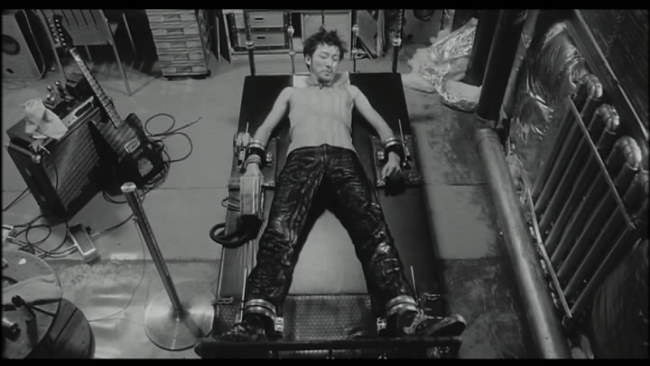
By the time they are both adults, somehow Thunderbolt Buddha, who spends his time attached to a satellite dish, scanning the city, finds out about Dragon Eye Morrison – worse, he decides that the world isn’t big enough for the both of them! So Thunderbolt invades Morrison’s apartment and kills some of his lizards and takes others prisoner. Sure enough, Dragon Eye Morrison figures out who the culprit is and they meet at high noon! From there – it. is. ON BABY!!!!
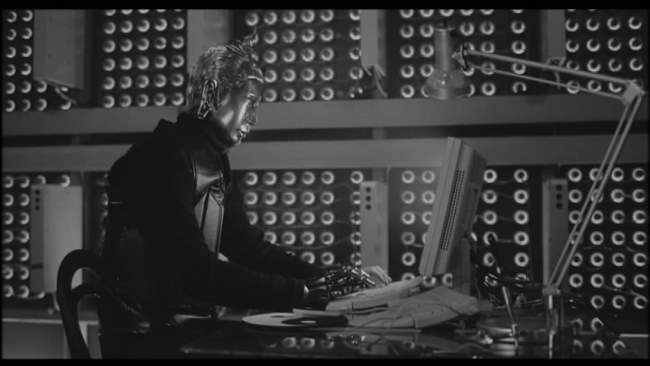
What the Fuck is This Movie About? Yes, at first glance, this movie appears to be pretty shallow and non-sensical, and it may just be. But I like deeper meanings, so allow me to intuit. OK – assuming there is any meaning one can derive from this movie, my wild ass guess is it is this – Dragon Eye Morrison represents the Dragon on earth personified, whereas Thunderbolt Buddha represents modern technology. At first glance, modern technology appears stronger than the earth (20,000 volts to 80,000), yet, due to his ability to bring the full might of the dragon to bare, he’s able to stand up to modern technology. What’s interesting about this theory is the reversal of fortunes: Dragon Eye Morrison gets transformed to merging with the Dragon (earth) due to the detrimental use of technology on him, whereas Thunderbolt Buddha is transformed by a natural occurrence – lighting. In a sense, both grow up reacting against that which transformed them. Or, um, my theory is full of bunk – you make the call. 
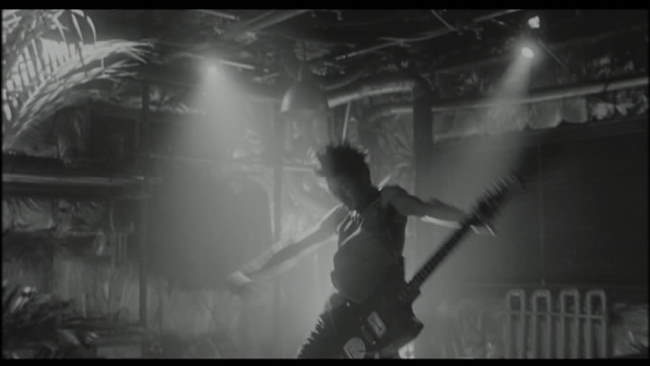
The Sound: As tightly integrated as can be, Electric Dragon 80,000V links massively loud and distorted guitar sounds with the kinetic visuals. This is really the true genius of Ishii’s work. Like all Japanese Cyberpunk movies, Electric Dragon provides an assault on the senses. Unlike most, the assault in this case isn’t as strong on notion of humanity itself, but is instead an assault on you, the viewer. To really experience this movie in the way it was intended, I STRONGLY recommend absolutely cranking the sound. If you don’t do this, you really will lose out on the mood this picture tries to set, and really, will not get the attraction
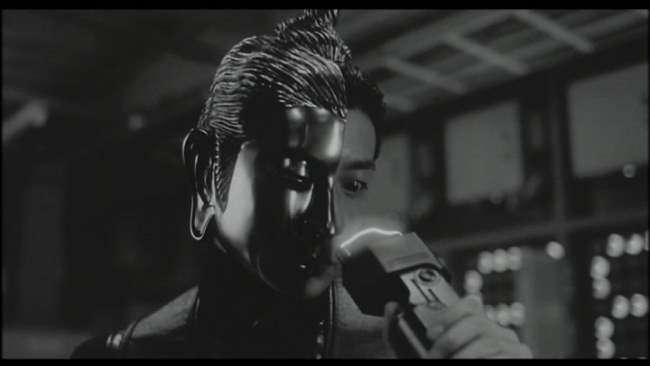
The Visuals: Electric Dragon 80,000V is really rather sedate for the first half. While well shot, the visuals aren’t really that noteworthy from a Japanese Cyberpunk standpoint. But the second half is FILLED with a bevy of truly bizarre shots. Electricity integrated with humans is the theme, and it is explored in a variety of ways, though showing various forms of electricity to kinetic shots of volts coursing through our lead characters. The second half uses the same style of stop-motion animation we get in Tetsuo - The Iron Man. While the movies are radically different, the movement of these two films is pretty similar.
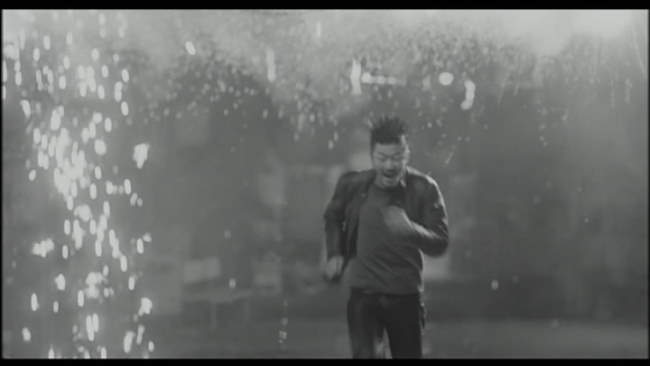
The Bottom Line: Electric Dragon 80,000V is clearly an indulgence in extremes. The mood brought on by the sounds and visuals far outweighs what little exists of the narrative. In the end, Electric Dragon 80,000V is either a movie you really dig or absolutely abhor. For this reason, I find it pretty difficult to give a solid rating, so I’ve gone with 7 stars - which implies that it’s a good movie, but one that some may not like. The entire thing is barely 50 minutes, so if you find yourself hating it, not to worry, it will be over soon. If you do like it though, Electric Dragon 80,000V has solid replay value.
~See movies similar to this one~
Movie Review By: SFAM
Year: 2005
Directed by: James Bai
Written by: James Bai
IMDB Reference
Degree of Cyberpunk Visuals: Low
Correlation to Cyberpunk Themes: High
Key Cast Members:
- Puzzlehead/Walter: Stephen Galaida
- Julia: Robbie Shapiro
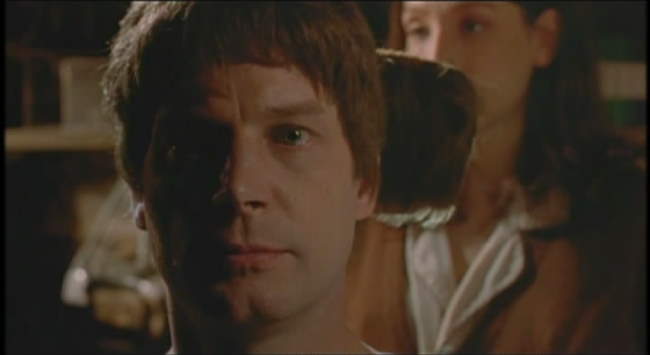
Overview: First let me give a great big THANK YOU to Puzzlehead Director, James Bai, who gave me a copy of this movie to review, even though it has not yet been released for general distribution (Indie filmmakers - take note! Feel free to send me your cyberpunk films to review prior to release!  ). In looking at the movie poster and in hearing from others, I just HAD to get a copy of this to watch. Puzzlehead is about as far as you can get from a Hollywood production. You won’t see fast-paced action sequences here (quite the contrary – the movie is very slow paced), nor will you get futuristic scenery, or high-end FX. But make no mistake – even though the cyberpunk visuals are sparse, this is DEFINITELY a cyberpunk movie. The themes introduced and the fractured sense of humanity are fully cyberpunk. ). In looking at the movie poster and in hearing from others, I just HAD to get a copy of this to watch. Puzzlehead is about as far as you can get from a Hollywood production. You won’t see fast-paced action sequences here (quite the contrary – the movie is very slow paced), nor will you get futuristic scenery, or high-end FX. But make no mistake – even though the cyberpunk visuals are sparse, this is DEFINITELY a cyberpunk movie. The themes introduced and the fractured sense of humanity are fully cyberpunk.
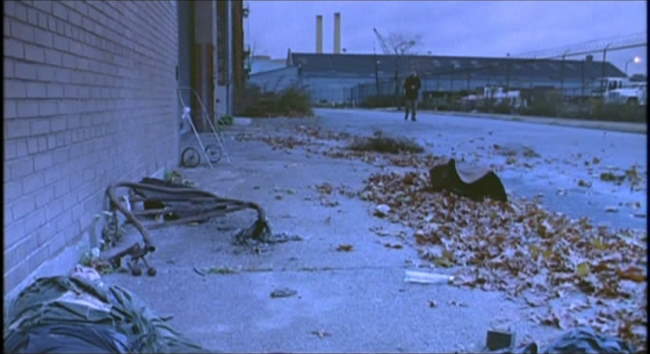
The Setting: Puzzlehead takes place in a futuristic dystopia, where all modern technology has been destroyed. Government still exists, but has devoted all resources for medical services. Unfortunately, the movie doesn’t give us enough intro as to why this occurs – the introductory narrative does mention that anti-federalists and the luddites forced the closure of all biomechanical laboratories (apparently they got rid of all “regular” technology in the cities as well), and that now, most resources are devoted to repopulation of the species. We can infer that the significant lack of people and an extreme reaction against technology coupled with at least a semblance of government might be due to some sort of genetic experiment gone awry.
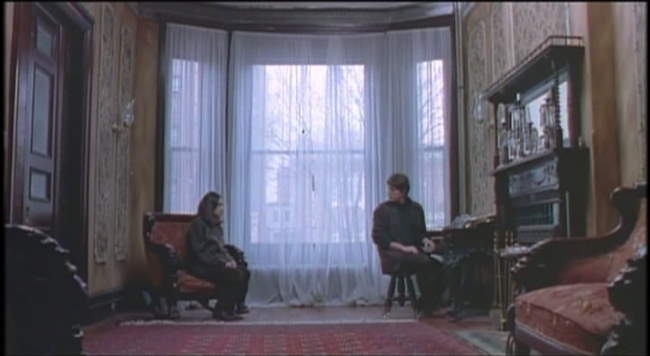
The majority of the movie takes place in a Victorian style townhouse, completely devoid of modern technology. Other sets include a decrepit, failing local grocery story, and a run-down apartment. Most external settings are comprised of run-down industrial areas. While the movie itself takes place in the future, aside for a few technology shots, the audience has to rely on the narrative and suspension of disbelief for this to work.
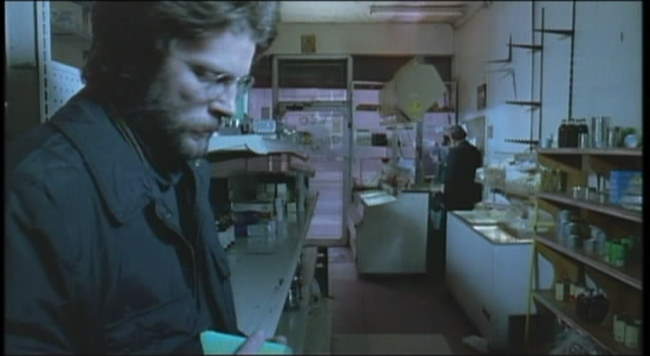
The Story: Humanity, it seems, is a shadow of its former self – random violence amongst is the norm, and virtually everyone we see in Puzzlehead is emotionally fractured. What little remains of the beleaguered populace is either making their way by becoming completely self-sufficient or by leaching off of others. It is in this setting that we focus on Walter – an emotionally fractured scientist who has trouble even walking out his front door. Unfortunately for Walter, he is in love with the very reclusive, local grocery store attendant, Julia (wonderfully played by Robbie Shapiro), but has never gained the courage to even attempt talking with her.
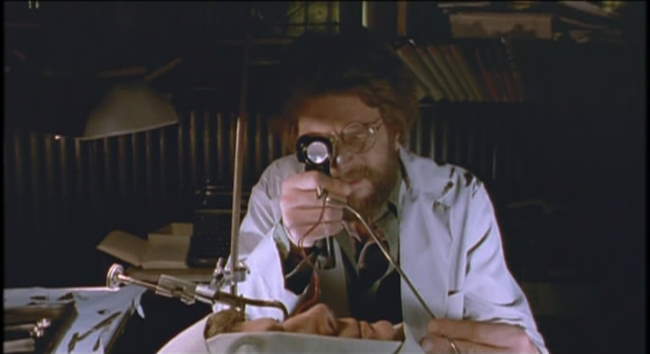
Walter (played by Stephen Galaida) decides to create an android named Puzzlehead (also played by Stephen Galaida) completely in his own image, apparently to serve as his external persona to interact in a world he prefers to avoid, and also to hopefully prompt interaction with Julia. After creating Puzzlehead, Walter spends significant time instructing Puzzlehead how to act. Walter is very derogatory controlling in his training of Puzzlehead. While Walter creates Puzzlehead with sentience, he severely restricts Puzzlehead’s behaviors. Over time, it becomes apparent to Puzzlehead that Walter has created and is using Puzzlehead for his own selfish purposes. In effect, Puzzlehead realizes that Walter sees him as nothing more than property. After Walter allows Puzzlehead to start venturing forth into society, he eventually comes into contact with Julia. Things get interesting when Walter follows up on Puzzlehead’s initial encounter with Julia.
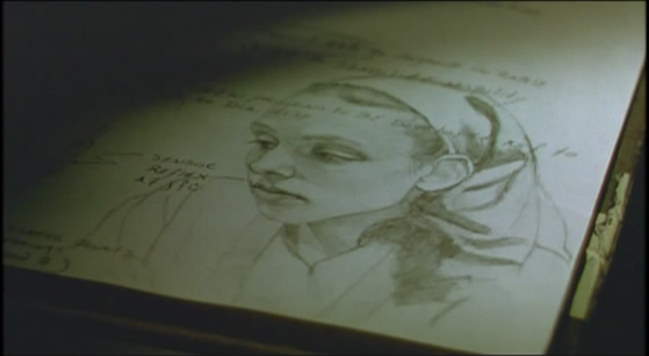
Puzzlehead Works Better on Second Viewing: Puzzlehead is told in narration format by the android, Puzzlehead, long after these events have taken place. In total, this approach works pretty well. Although, it does have the added side-effect of making the movie work better upon second viewing. There are a number of apparently throw-away comments that the narrator (Puzzlehead) gives that the audience simply can’t process until they’ve seen the story. However, upon second viewing, this adds a context to the movie that is missing the first time through.
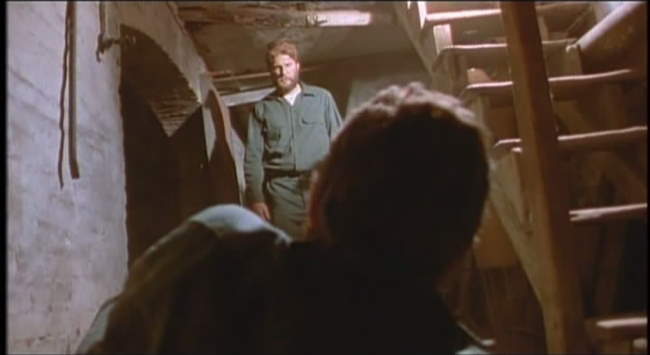
The Cinematography: Because the pacing in Puzzlehead is very slow, it runs the risk of inducing audience boredom. Luckily, this is largely overcome by the continually excellent shot selections throughout. It’s clear that significant thought went in to camera angles and interesting lighting approaches. Continually, we are treated to shots with extreme close-up foreground elements with action and movement occurring in the background. This approach, along with many low angle shots contributes to the sense of alienation the narrative provides.
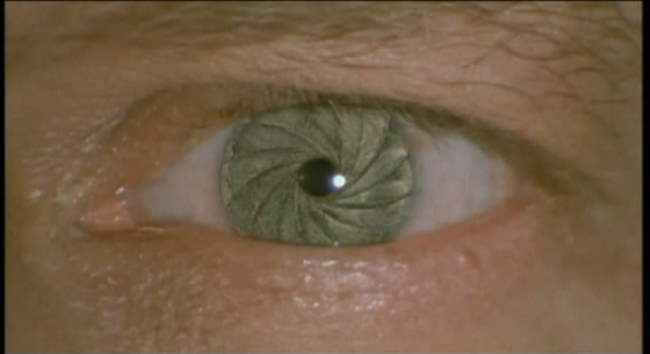
How does an Android Develop “true” Freewill? Puzzlehead provides us with a very interesting take on the development of android sentience and self-awareness. Puzzlehead is created using a neuron-scan from his creator’s brain (Walter), and thus, has all of his memories (yet, most are rendered meaningless without the context) – unfortunately, this scan has also left Puzzlehead riddled with Walter’s flaws. Puzzlehead’s biomechanical brain, like a human’s brain, is structured and controlled by belief structures and associative memories. Emotions, which are already troubling and confusing for Puzzlehead, develop into uncontrollable deviant behaviors.
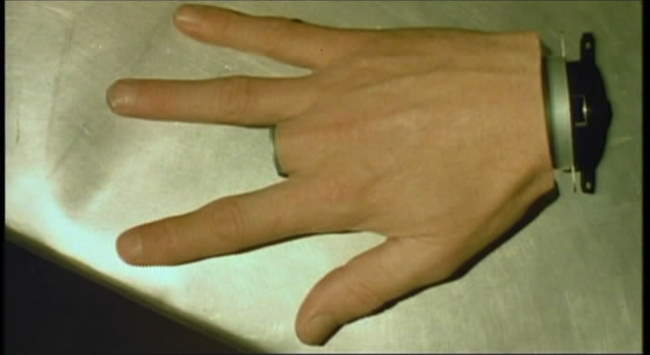
As Puzzlehead begins to develop self-awareness and freewill, he notices these tendencies that control him. These behaviors impact Puzzlehead’s ability to act the way the “real” him wants to act. His android brain, a combination of (undefined) biomechanical parts, is similar to a human’s in that he can recognize when he is doing deviant behavior, but cannot change his actions. But unlike humans, because Puzzlehead is an android, he can consider options for reprogramming his initial operating conditions. One question Puzzlehead ultimately poses is this – do androids have the possibility of becoming “exactly” the type of sentient being they want to become?
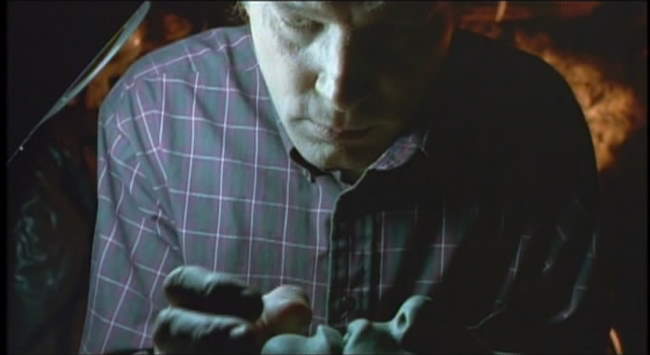
This potential ability to be “perfect” in the sense of transforming into exactly what Puzzlehead wants to become serves to reinforce Asimov’s notion that sentient robots would consider themselves superior to humans. In Puzzlehead, we get a realistic glimpse of how this might look.
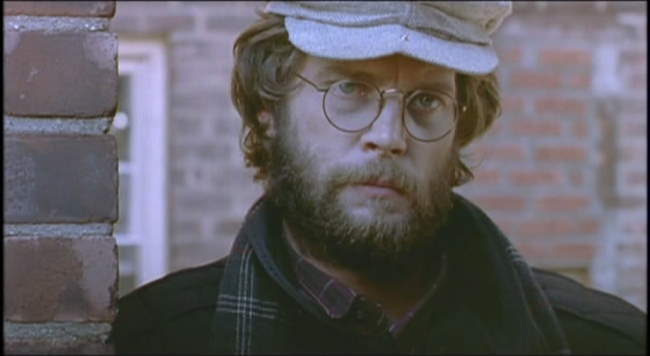
Puzzlehead is an Intensely Personal Film: In judging this movie strictly on what I could learn from watching it I give it 7 stars (I would give it 7.5 if I had half stars – something I’m still working on). As a bonus, in talking with the film maker, it turns out that the film itself is an intensely personal metaphor of James Bai’s – one that you would never guess but makes perfect sense once you are told of it. Watching it with this knowledge, the complexity of the movie itself ramps up significantly, as does its accomplishment as a film – so much so that I’m strongly inclined to add another star to the review. I won’t give this part away, but instead offer Mr. Bai the opportunity to comment here if he would like to describe Puzzlehead’s personal nature in his own words.
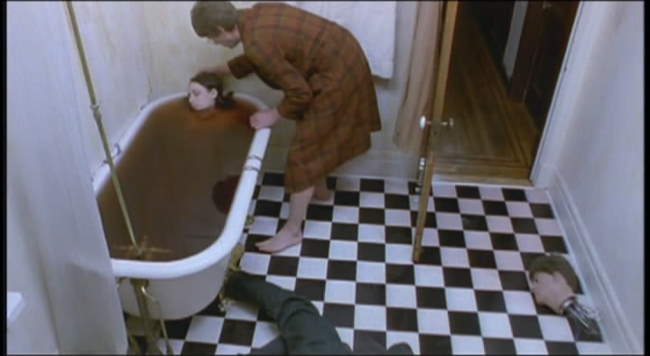
The Bottom Line: James Bai has created a very low-budget flick that’s definitely worth a watch. While I had some problems with the acting in some of the early scenes (Galaida as Puzzlehead acts way too human at the beginning, but eventually settles into the role), and a few of the visuals which seemed too 70s looking, these are diminished as the movie progresses. Bai poses some interesting thoughts on android development – some of which are unique to movies. If you can stand a very slow-paced, intellectual cyberpunk flick without a lot of cyberpunk visuals (although I LOVE the bathroom and broken arm scenes), Puzzlehead is definitely worth a watch.
~See movies similar to this one~
Movie Review By: SFAM
Year: 2002
Directed by: Gary Fleder
Written by: Philip K. Dick (story), Scott Rosenberg (Adaptation), Caroline Case et a. (screenplay)
IMDB Reference
Degree of Cyberpunk Visuals: Medium
Correlation to Cyberpunk Themes: Medium
Key Cast Members:
Spencer Olham: Gary Sinise
Hathaway: Vincent D’Onofrio
Maya Olham: Madeleine Stowe
Cale: Mekhi Phifer
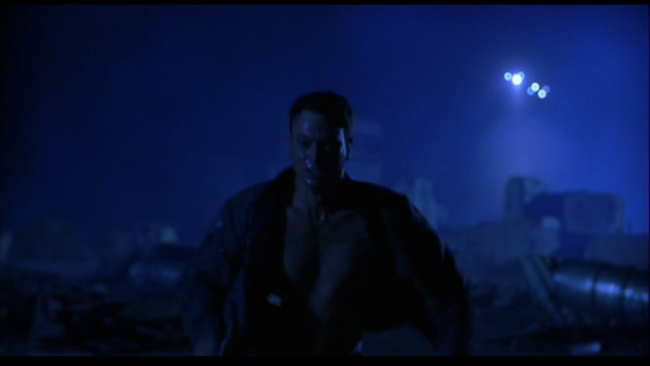
Overview: Impostor got bashed by critics for having bizarre cut always, too many slow motion scenes, and generally weird and herky-jerky cinematography decisions. Additionally, others criticize it due to originally being a 30-40 minute short that got extended into a full-length movie. While all true, I truly like both the story (basically the Fugitive, done in a near future setting) and the acting, especially by Gary Sinise and Madeleine Stowe. While the cinematography is definitely subpar in this Philip K. Dick story, the movie itself is still worth a watch.
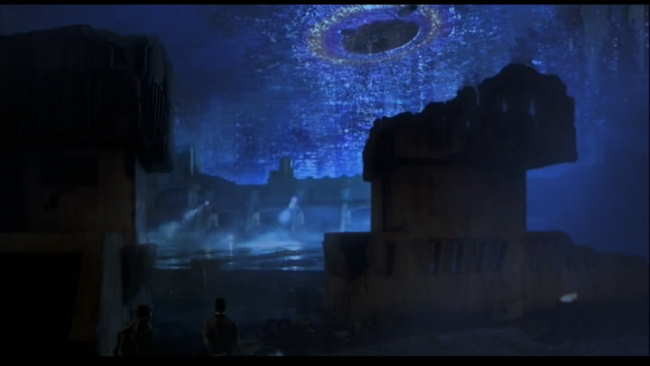
The Story: Impostor is set in the year 2079, a time when a race of aliens are attempting to invade the earth. To protect the population, humans now live in high-tech “bubbles” which seem to be able to keep out Alien weapon systems. Because of this, the aliens have resorted to creating DNA-based replicants, not unlike those in Battlestar Gallactica, by a process which apparently involves copying captured humans. These replicants are in actuality very powerful bombs, but have no self-awareness of being replicants – when their “trigger” is invoked (such as being in close proximity to their target), they explode.
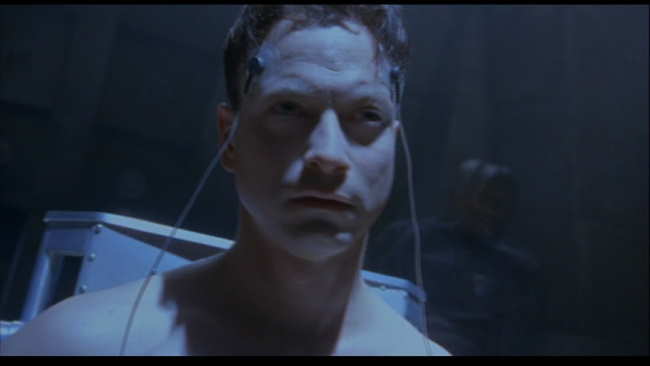
Sinise plays Spencer Olham, a weapons scientist who has been accused of being replaced by a replicant (called a cyborg in the movie). The security head (Vincent D’Onofrio) captures him and threatens to rip out his heart in order to prove that he’s not a human. Sinise escapes and then engages on a journey to prove his innocence. Olham determines that he can prove his innocence by equipment at the hospital where his wife (Madeleine Stowe) works, that compares a previous body scan with his current body. Unfortunately, he’s already gotten out of the city, and now needs to figure out how to get past security to return.
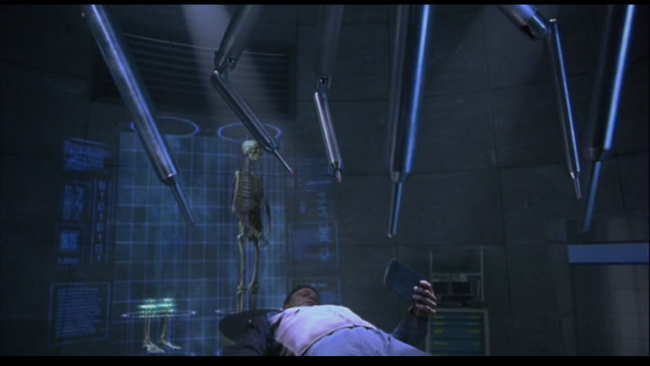
How Do You Know You’re You? This, in essence is the question Impostor is asking when it’s not in chase-filler mode. Is Spencer Olham a human caught in a horrid mistake, or is he a cyborg comprised of human-like bio-matter that is in actuality a powerful bomb sent by aliens to infiltrate Earth’s defenses in order to kill human leadership? If you were a cyborg-replicant imbued with the memories of the original host, how could you figure it out? Imposter briefly mentions the notion that the cyborgs don’t have a soul, but this is never pursued. One wishes they had come up with some way of quantifying a soul. But in the end, we are left to answer this question ourselves.
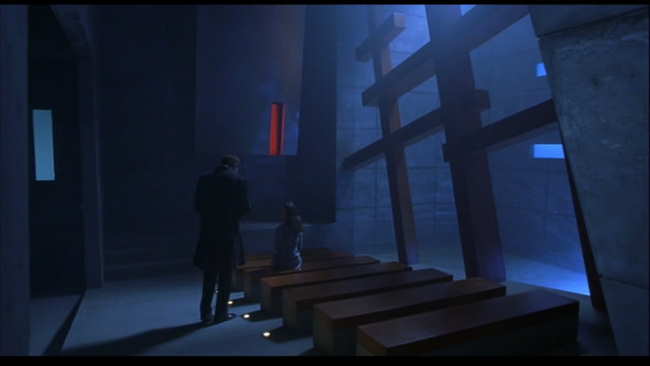
The Middle “Chase” scenes are Filler: Originally, Impostor was shot as a 30-40 minute movie short that was intended to be part of a larger collection. Apparently, Miramax liked the short enough (or cooled to the short collection idea) that they wanted it extended into a full length feature film. However, in doing so, they were left with a relatively tight beginning and tight end, and then a vast chasm of nothingness in the middle. By and large, the middle is filled with semi-pointless chase scenes that are sprinkled with people that aren’t germane to the central plot. Now we get a whole underground dystopia thing added to the mix, whereby it turns out that the nice hospital is ONLY for those who live in the bubble, while those in the outer area get little or no medicine and support. In its better moments, the middle part of the movie seems to want to emulate a “Fugitive” type feeling, but this doesn’t always work well. The DVD also includes the original movie short which is definitely worth a watch.
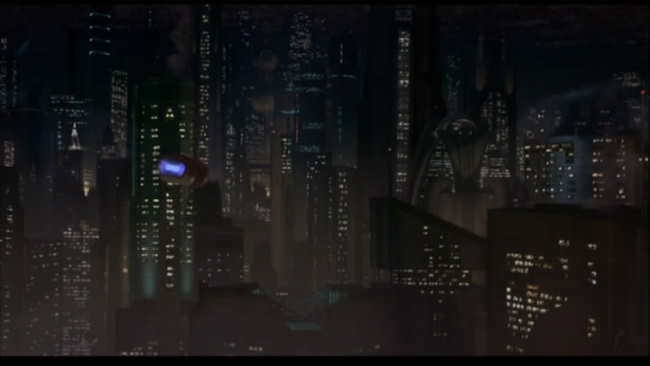
The Visuals: Impostor’s vision of the future is terrific in some places and haphazard in others. The cityscape scenes look right out of blade runner, the bubble city coverings, torture look great, but the majority of Imposter involves treks through regular looking tunnels. The torture equipment and medial imagine equipment are both more than passable. Imposter is strongly dominated by blue tones, which pervade most every aspect, from the chase scenes to the interrogation scenes.
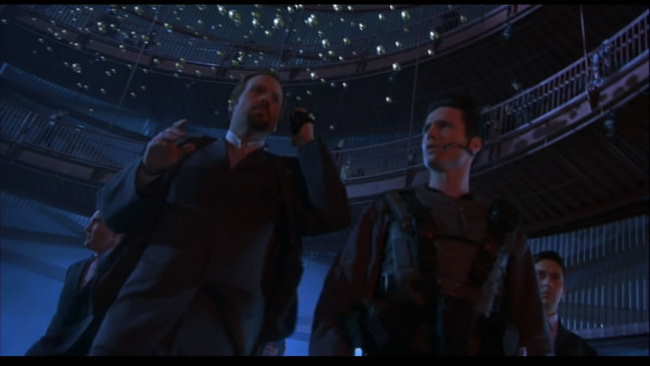
The Acting: By far, the best aspect of Impostor is the acting.Gary Sinise in particular really sells his role well, but Madeleine Stowe and Vincent D’Onofrio also give high quality performances, and Mekhi Phifer is at least passable. With slightly worse performances, Imposter could have easily ended up in the cheesy “B” Movie bin. The effects are uneven enough (some looked great, others looked TV-ish) that solid acting was a must to keep this movie watchable.
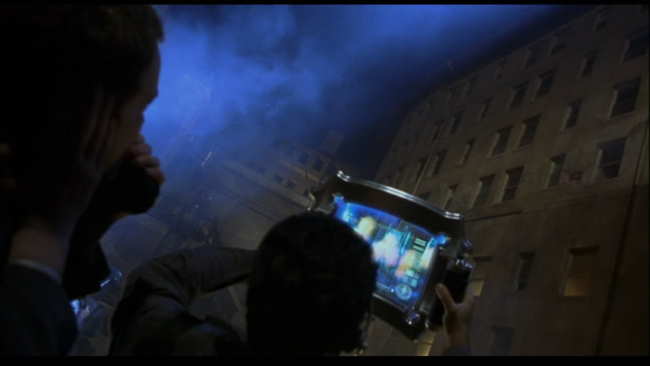
The Editing: Impostor is rightly criticized for crazy and continuous cut-shots. Rare is the shot that lasts more than 4 to 5 seconds before cutting to another view. The goal was to add to the tension of the chase scene, but the editors went overboard. Especially when combined with some strange shot angles, Imposter almost takes on an experimental vibe, as if they weren’t sure what would work, so they tried various different things.
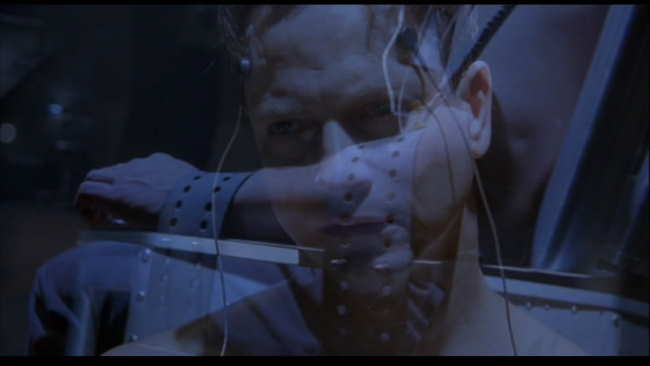
The Bottom Line: While this “Fugitive-like” movie has lots of interesting scenes, it’s the ending that I really like - definitely a cool twist. The acting is solid and the visuals are sometimes, but not always, pretty decent. There are lots of pointless tunnel-running that easily could have been cut by 15-20 minutes, and also, there are enough questions and plot holes that stop Imposter from being a great movie. Still, the question of determining humanity is an interesting one, and is well executed.
~See movies similar to this one~
Movie Review By: SFAM
Year: 2004
Directed by: Shinji Aramaki
Written by: Masamune Shirow (Manga), Haruka Handa & Tsutomu Kamishiro (screenplay)
IMDB Reference
Degree of Cyberpunk Visuals: Very High
Correlation to Cyberpunk Themes: Medium
Key Cast Members:
Deunan Knute: Ai Kobayashi
Briareos: Jûrôta Kosugi
Hitomi: Yuki Matsuoka
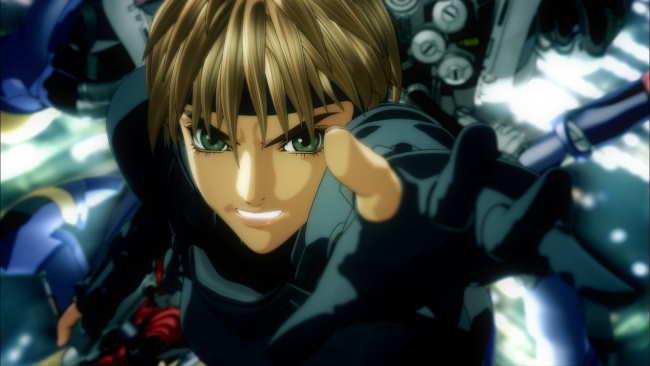
Overview: Masamune Shirow’s Appleseed recently got a second anime treatment. The last was in 1988 – this time, in 2004, the anime is done up in eye-popping 3D graphics. With a budget of only 10 million as compared to over 90 million for a movie like The Incredibles, we shouldn’t be expecting too much. Surprisingly, we get far more than expected, especially with regards to the wonderfuly rendered backgrounds. While the animation is interesting enough, the story is more problematic. So too are the change in the feel of the characters. This is really where the original version succeeds far better than Aramaki’s version.
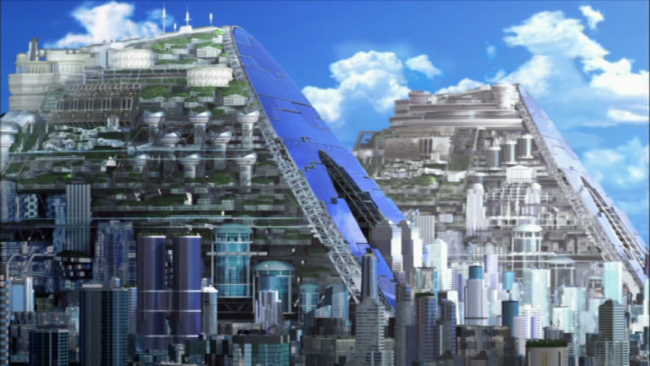
The Story: Appleseed takes place in the year 2131, a war-ravaged dystopian future where most all of human society is in ruins. Over two years after the last war, the only example of advanced human civilization is a newly made city called Olympia, which has been engineered to be a created as a perfect refuge from the rest of the world. Over half of the city’s inhabitants are comprised of bio-engineered “biodroids,” which are human-like beings designed to serve specific roles in the society. An all-knowing computer named GIA supports the city council in controlling all aspects of city life.
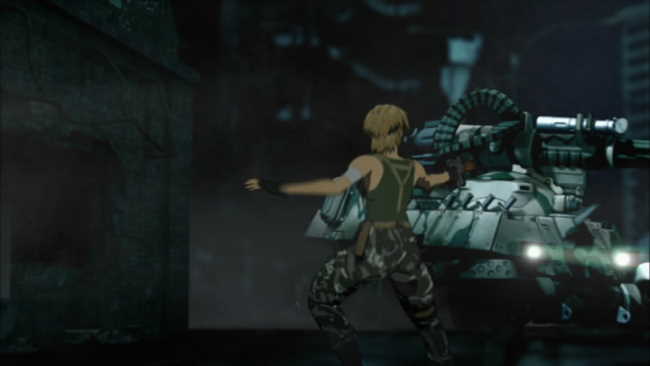
Deunan Knute, a fighter extraordinaire has been living alone in the wastelands, not realizing that the war is over. She is beset by two warring groups of fighters, one of which who is trying to kill her, and the other group, which rescues her and takes her to Olympia. There she is re-acquainted with her long lost lover, Briareos, who now has been transformed into a cyborg after his body was lost in the war. She is tasked to join “ESWAT,” a special mecha-enabled police force that keeps order within the city. Deunan also befriends a biodroid named Hitomi, who shows her around the city. Unfortunately, Deunan barely gets a chance to settle down before the assassination attempts on her life start.
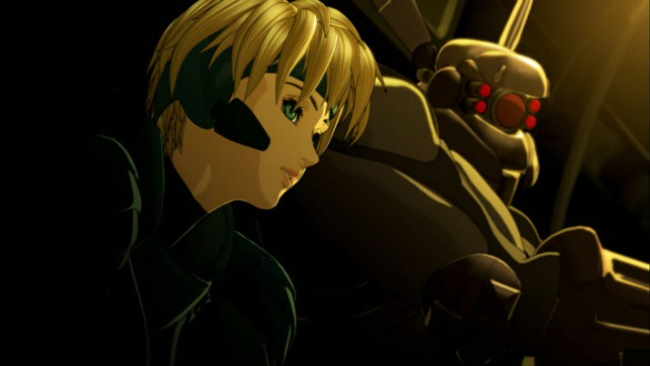
Duenan quickly learns that she has been dropped in the middle of a power struggle between humans, who are concerned that the biodroids secretly aim to exterminate them, and biodroids, who worry the same about the humans. Somehow, Deunan has become essential in this struggle, yet it has nothing to do with her fighting capabilities. It turns out that her parents, before dying, developed a method for biodroids to reproduce, which would make them almost exactly like humans. But this research was lost long ago. Now, Deunan has become a pawn for both sides of this struggle, and worse, it appears as if her ex-lover, Briareos has chosen sides.
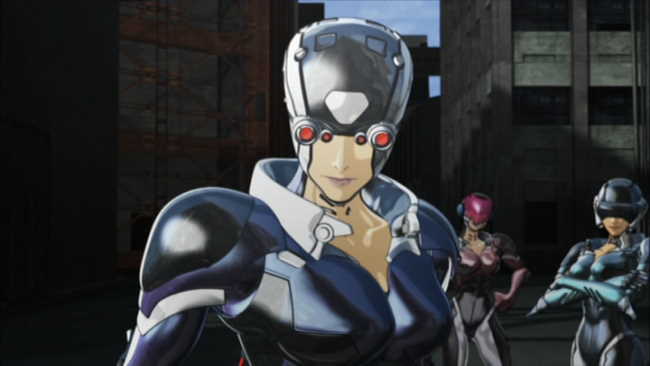
Unfortunately, the story in this version of Appleseed is problematic at best. There are too many sub-plots that obfuscate the key points. The myriad of loose ends introduced that are never followed up on. Gia, the sentient computer that runs Olympus is the probably the worst casualty. We get introduced to her, and, if you know something of the Appleseed story from the Manga, you expect to see lots more than what actually ends up being conveyed. In the end, the plot centers on a simple theme of racism. This is a shame as there were so many interesting cyberpunk aspects of Olympus that get short-circuited.
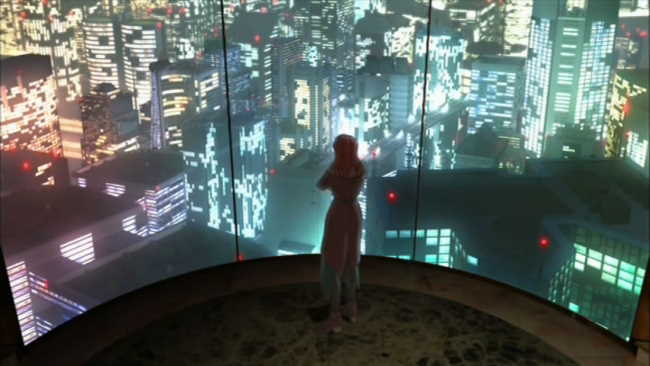
The Animation: Appleseed’s backgrounds are wonderfully rendered. This more than anything accounts for the majority of the “wows” Appleseed received. They are done in a way that allows 3D camera maneuvering, so as to allow you to see the same scene from multiple angles, and at times, even provides Matrix bullet-time effects. For the most part, the 3D CG overlaid with 2D cell shading really works. It’s an extension of the idea we saw in Malice@Doll, only with far better rendering tools. The machines look especially awesome. Both the Gunhed style tanks at the beginning of the movie and the platform sentinels at the end. Unlike many cyberpunk movies, there isn’t a dominating color palette in Appleseed, but the color scheme seems to stick more often than not to light and dark shades blue-greens, with yellow & browns in transition scenes.
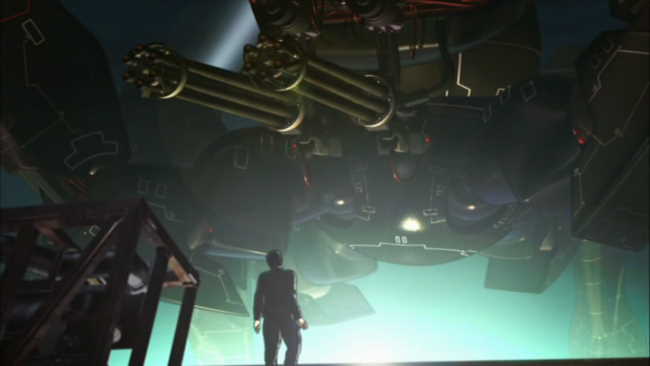
In terms of the characters, only Deunan Knute really looks polished. Her body movements, facial expressions and general actions really work. The rest, especially the human characters, often look stilted in their moments. Hitomi, their biodroid friend, is especially problematic at times. This might be due more to the motion-capture techniques they use, which work wonderfully for the city, but not so well for the characters. Also, I really dislike the way they animated the hair. The hair on the humans in the 2004 edition look like something out of Reboot. However, considering the budget, I think they made the right decision in spending scarce resources on Deunan. Had they just made everyone look slightly better, Appleseed would have faltered horribly. By at least making Deunan polished, they developed a star that fit right alongside their wonderful backgrounds.
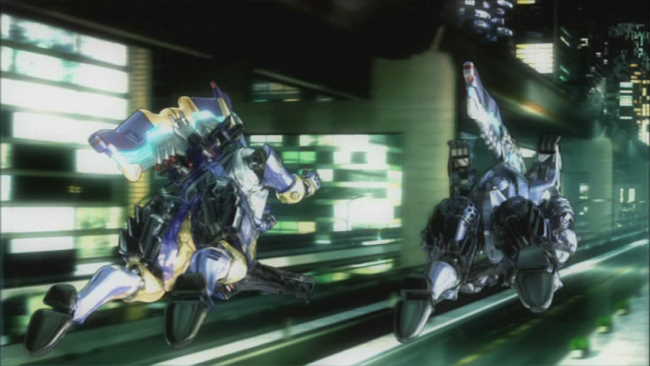
The Sound: Many times throughout the anime, Appleseed plays more like a music video than it does a movie. The modern heavy rock beats worked well for the action scenes. And truly, the action scenes are where Appleseed excels. There, the 3D positional sound, the music accompaniment and the 3D CG graphics are at their absolute best. The accompanying score really wasn’t all the memorable, but at least served up the slower paced moods fairly well.
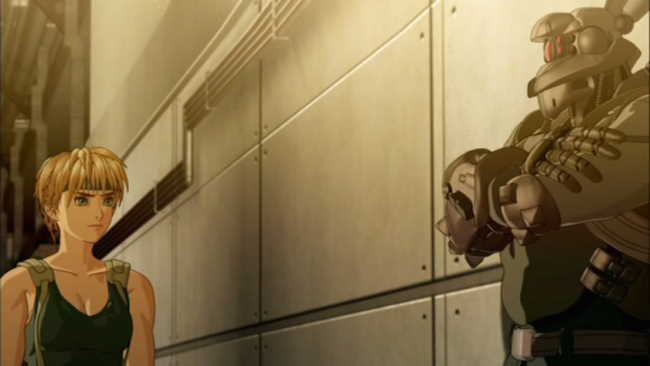
Differences From Shirow’s Work: While both animes deviate from Masamune Shirow’s Appleseed Manga, Aramaki’s version is the most egregious. While the 2004 version starts outside of Olympia as the Manga does, it only has Duenan there, whereas in the Manga has both. This version introduces a new dramatic twist of Duenan and Briareos getting back together for the first time in two years. While this in itself isn’t bad, the side-effect is: these two characters are no NOTHING like the Manga. The Duenan Knute and Briareos of Shirow’s Manga, and of the 1988 version, are precursors to the Ghost in the Shell’s Motoko and Batou. Here, Briareos is a moody, lost soul trying to deal with his cyborg body, and Duenan is far more vulnerable than tough. The playful chemistry we see between these two both in the Manga and the 1988 anime is completely missing here. For those who aren’t familiar with the Manga, this probably won’t bug you, but it certainly sapped some of the enjoyment out of this movie for me – so much so that I’m dropping a star off the review for it.
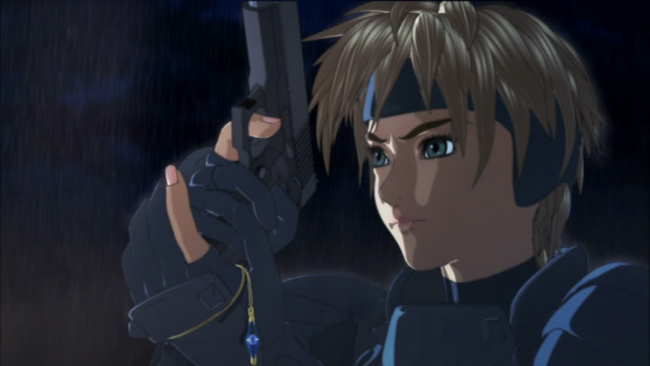
The Bottom Line: Appleseed is definitely worth seeing for the visuals alone. While some of the characters don’t work, the Duenan, the machines and the action scenes work wonderfully. Unfortunately, the story doesn’t equal up. Too many elements are introduced and then discarded in favor of a truly simplistic storyline. They could have done better. Also, as I mention above, this is not the Deunan and Briareos I’ve become familiar with – these characters are different from both the Manga and the earlier anime. This bugged me enough to drop a star from the review, but you might not mind so much.
Page 2: More Screencaps –>>
~See movies similar to this one~
Movie Review By: SFAM
Year: 2001
Directed by: Steven Spielberg
Written by: Brian Aldiss, Ian Watson & Steven Spielberg
IMDB Reference
Degree of Cyberpunk Visuals: Very High
Correlation to Cyberpunk Themes: High
Key Cast Members:
David: Haley Joel Osment
Gigilo Joe: Jude Law
Monica Swinton: Frances O’Connor
Prof. Hobby, the Visionary: William Hurt
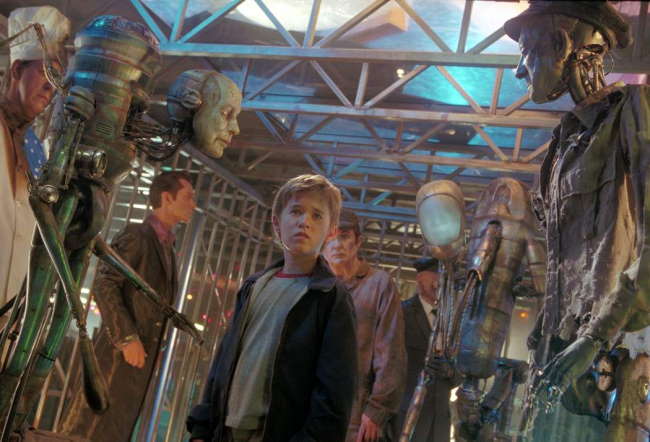
Overview: Originally convieved of by Stanley Kubrick, Spielberg took the reigns of this wonderful Pinocchio tale done in cyberpunk. This story is about a robot who wants to be a “real boy” so that his mother will really love him. Like Pinocchio, he goes on a journey of discovery. Although there are a few over-the-top scenes, the FX is awesome and the acting is wonderful. AI definitely inspires discussion if nothing else.
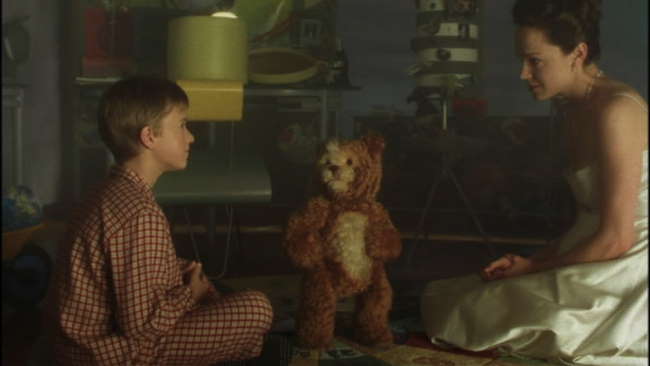
The Story: Set in a near future where global warming has led flooding of all the coasts, and a general breakdown has occurred in many parts of the world. Robots, called Mechas, are common in society now, and perform a variety of functions. Unfortunatley, there is widespread public outcry against their very existence. The focus is on a single family, where a mother has essentially lost her son, who now hangs on to life in cryogenic freeze. Her husband convinces her to get a new model mecha to replace their son – this one becomes hard-wired to its owner and experiences real love and emotion. After accepting their new mecha, a child named David, the family’s life seems complete – until their real son miraculously recovers from his illness.
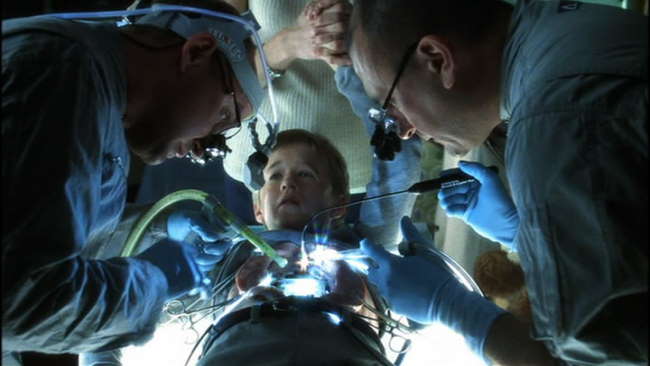
Their real son feels threatened by David, and after a sequence of incidents, David’s mother is forced to send David back to his maker for destruction. But while driving him to his death, she cannot bring herself to follow through, and instead sets him free. In a traumatic breakup, David’s mother warns him of the dangers of the outside world before leaving him alone with just his Teddy toy. David, having been read Pinocchio, decides that if he can find the Blue Fairy, he can convince her to turn him into a “real boy.” Along the way, he encounters Gigilo Joe, who helps him on his journey.
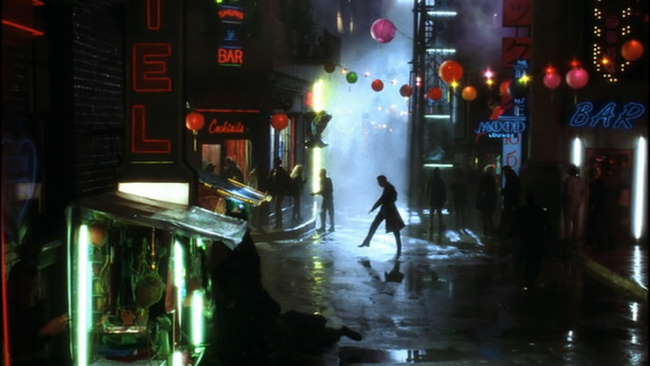
The Acting: The acting in AI is consistently terrific. Haley Joel Osment puts in a performance you’d never expect to see from an actor so young. He is utterly believable both as a mecha, and as his journey proceeds, seemingly transforms into a regular acting boy. Jude Law puts in a terrific performance as Gigilo Joe – one that almost transcends the movie itself as a memorable character. Frances O’Connor also delivers a fine performance as David’s mother, as does William Hurt as David’s inventor.
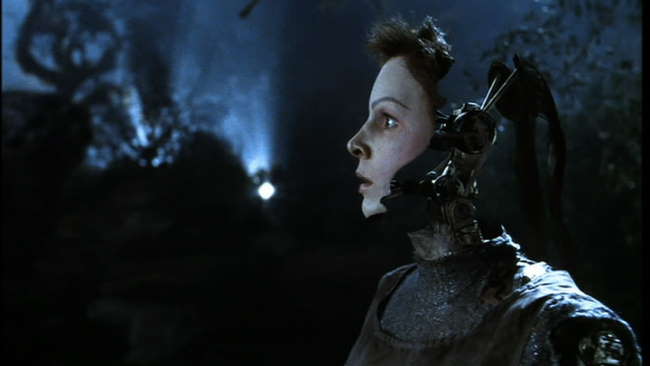
The FX: The visual effects in AI are still among the best that’s ever been put on film. The mechas (robots) look incredibly real – far more real than should be possible. There are many different kinds of mechas, many of which are represented here, but none are better than the Nanny. She is breathtaking. The entire front-end of the movie gives us a very normal set of surroundings. Other than the cars, and minor mecha parts, we aren’t dazzled by the upfront effects. This makes the second half all the more impressive. When David goes outside, things change dramatically. From the robots, to the city-scapes to the destroyed New York, this AI is a visual feast. To top it off, the Teddy Bear is maybe my favorite robot character of all movies.
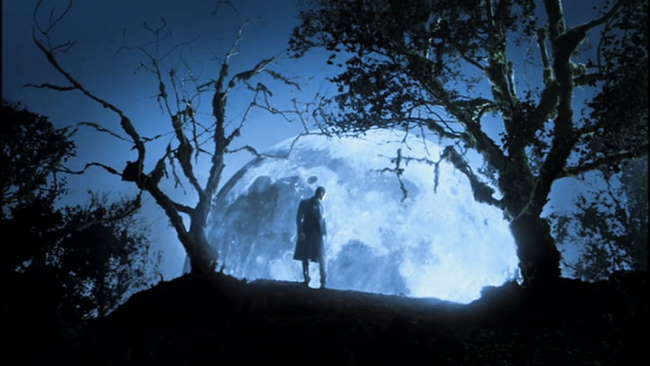
The Score: John Williams is as awesome as ever in creating the score for AI. He is able to capture the feeling of the dregs of humanity along with an almost heavenly sense of love and contentment. The score really brings the movie together in places that with something lessor it might not have worked.
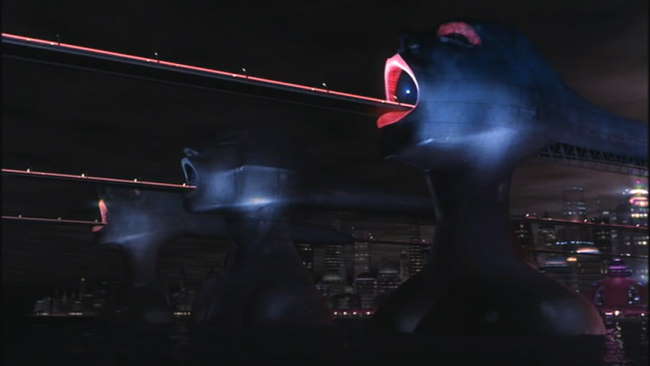
Kubrick versus Spielberg: AI is a strange movie in that it encapsulates a harsh Kubrick-style future while at the same time has a story that lends itself to Spielberg’s Capra-like tendency for the emotional mushiness. In watching AI, rarely do the two tendencies meet up well. We either have the dystopic craziness of the Flesh Fair or the serenity of the beginning. We also see dramatic changes in pacing. In some parts, we have a very slow, deliberate movie, whereas in others, it seemingly breezes past key scenes.
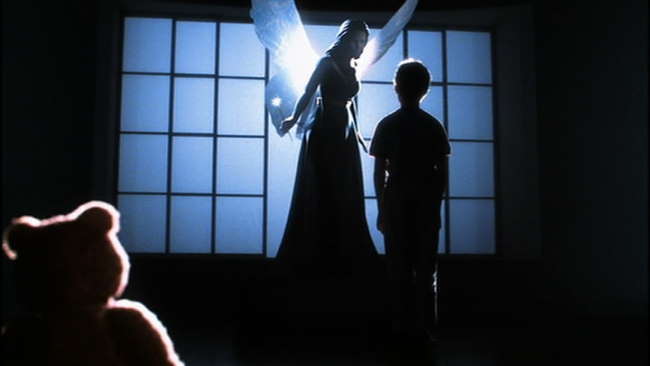
Some thoughts on the ending: Many folks who generally like the movie end up hating the ending. I don’t have this issue - in fact I like the ending, but I do understand the sentiment. The ending really does drop into a completely different movie altogether. In effect, it becomes the fairy tale that David pursues the entire movie. But because I KNOW the ending engenders discussion, I am concerned about spoilers in the comments below. PLEASE don’t post spoiler thoughts - if you do, your comment will be deleted. Instead, I’ve created a thread in the meatspace to discuss the ending of AI.
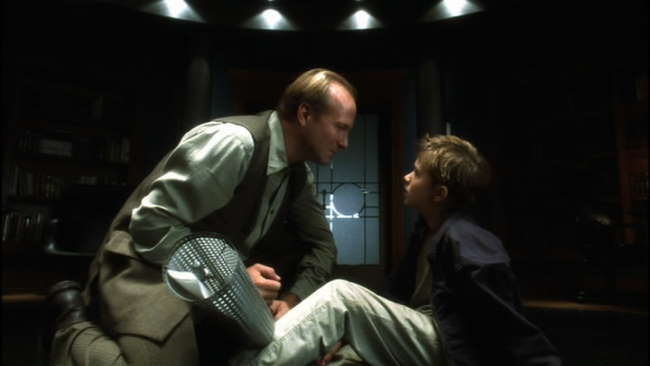
The Bottom Line: AI is a visual feast of dystopia and human morals run amok. As the same time, it’s a beautiful love story about the best of humanity. Many have issues with the ending, although, it works fine for me. While the actions in the Flesh Fair are bit outside believability, overall, the story is very well done. The CG is among the best ever on film (check out page 2 below if you want to see more screencaps). It doesn’t serve to astonish us, but instead, attempts to integrated seemlessly into the film. The acting is terrific, especially from Haley Joel Osment (David the robot boy) and Jude Law (Gigolo Joe). On top of this, we get a very interesting portrayal of a future with sentient robots who do not have any rights. One can almost see the Animatrix’s Rennaissance occurring shortly afterwards.
Go to AI, Page 2: More Screencaps –>>
~See movies similar to this one~
Movie Review By: SFAM
Year: 2002
Directed by: Terry Cunningham
Written by: Flavia Carrozzi, Terry Cunningham & Steve Latshaw
IMDB Reference
Degree of Cyberpunk Visuals: Low
Correlation to Cyberpunk Themes: Medium
Key Cast Members:
Nick ‘Jester’ Chase: Nick Cornish
Neville: Adrian Paul
Skylar: Bai Ling
Tess Woodward: Vanessa Marcil
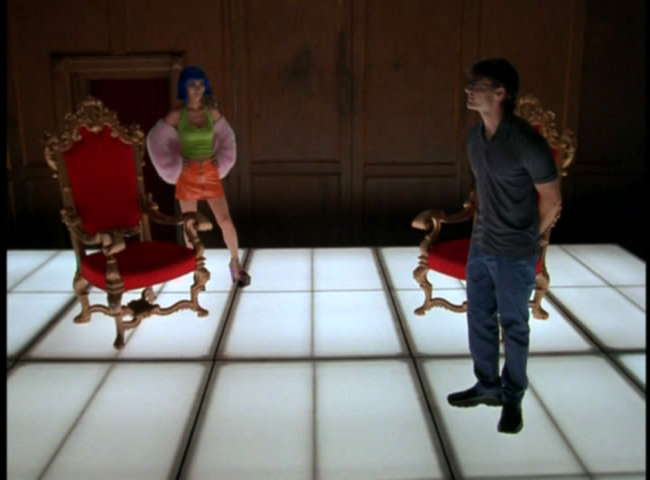
Overview: Overview: Codehunter (a.k.a. Storm Watch) is a fun, but absurd low budget AI and VR flick. This is not a movie who’s technical plot holds together, but it does work as a bubble-gum current-setting hacker-cyberpunk romp. Code Hunter is another War Games-Hacker-Colossus, the Forbin Project rip-off, but in a simplistic and enjoyable way. I’m a sucker for movies with either Bai Ling and Adrian Paul in it. Along with those two, the supporting cast which includes Babylon Five’s Jerry Doyle, Vanessa Marcil and Nora Dunn is pretty fun too.
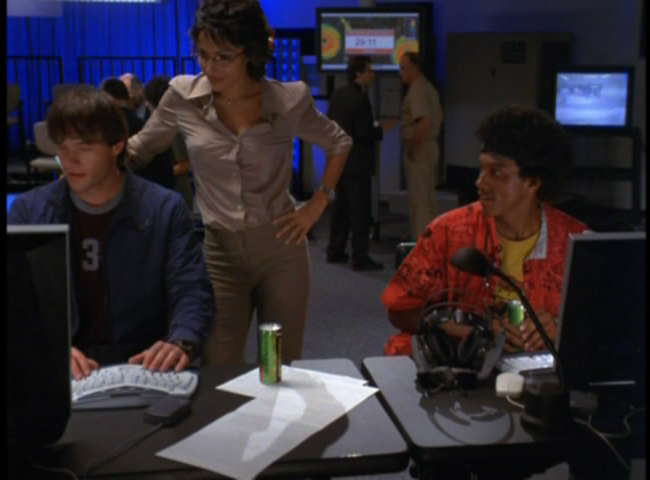
The Story: Nick “Jester” Chase (played by Nick Cornish) is a reformed hacker who likes to hang out in a VR first person shooter game called Shock. Simultaneously, a small computer firm is attempting to sell the US Navy on a new satellite system called “Thunderhead,” which is designed to control the weather. Nick is contacted in the game by Skylar (Bai Ling), a computer genius extraordinaire, to steal a file from an unknown computer system. After refusing, Skylar blackmails Nick by modifying his record to make him a wanted fugitive. Skylar agrees to steal the file, but then hides it and tries to go to the news station to seek protection. He enlists the aid of up and coming reporter, Tess Woodward (Vanessa Marcil), who agrees to help him.
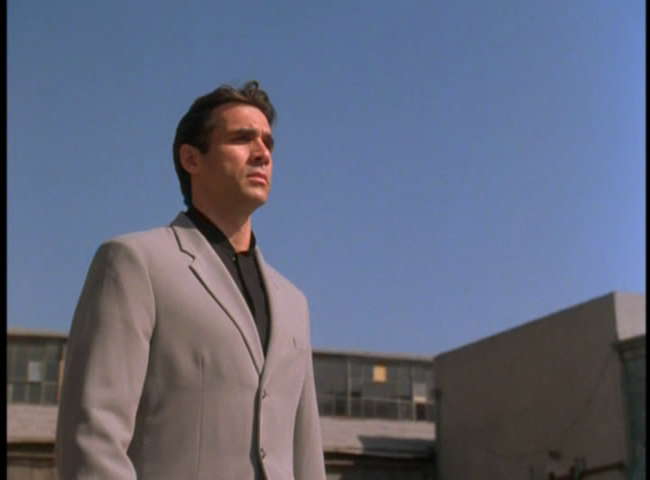
Unfortunately, Thunderhead appears to be out of control, and has created two massive hurricanes on each side of the US that will devastate the both coasts, causing potentially millions of deaths and billions in damages. The government tracks down Nick and bring him in for questioning. As the plot unfolds, it appears that a strange connection between the VR game “Shock” and Thunderhead emerges. Unless they can unravel it, the consequences will be catastrophic.
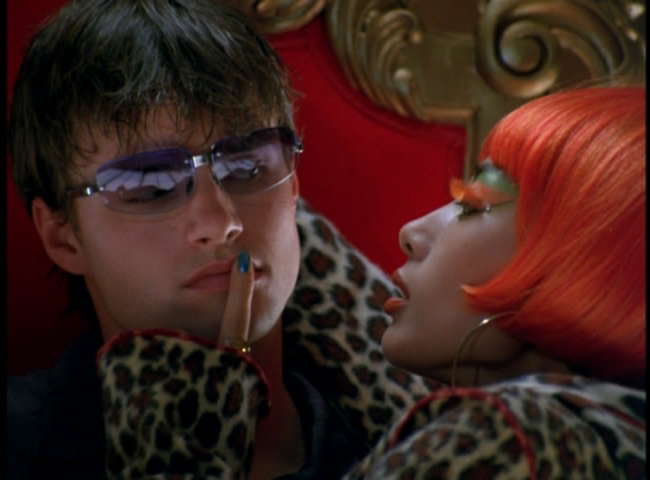
The Bottom Line: Although the cast is fun, and the pacing is good, the actual plot points and coherency are well past the point of believability. They are too numerous to count, but suffice to say the good guys had a number of obvious solutions that could have stopped the catastrophe. To add insult to injury, the movie overstretches its AI angle – had it stopped earlier, it would have worked within the narrative, but instead, they go for the sappy “teach me all of humanity” angle. Again, the movie is fun to watch, but lacks any real intelligence.
~See movies similar to this one~
|






































































































